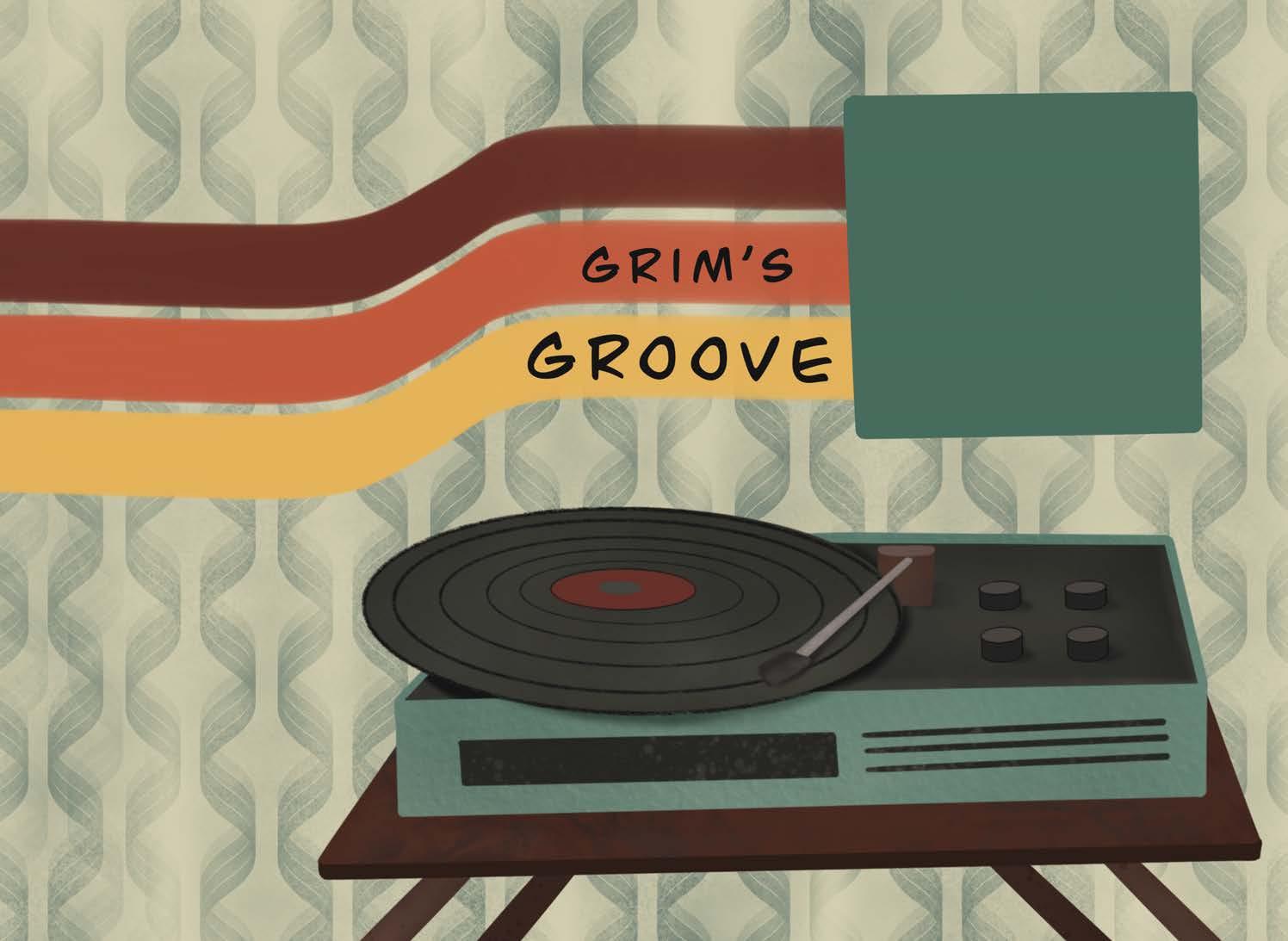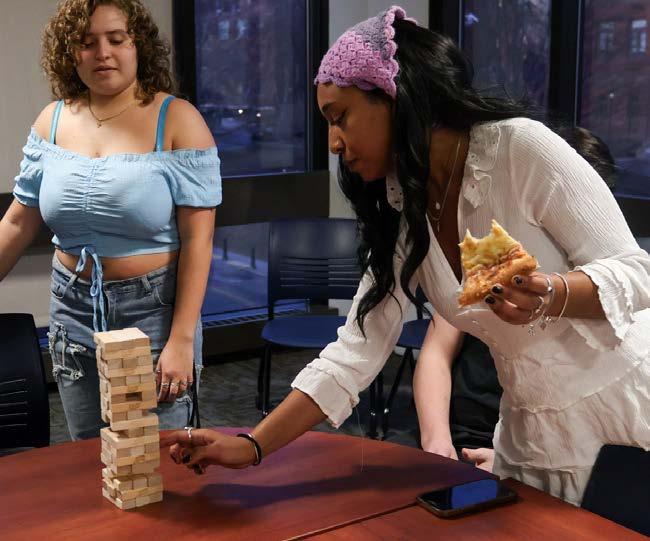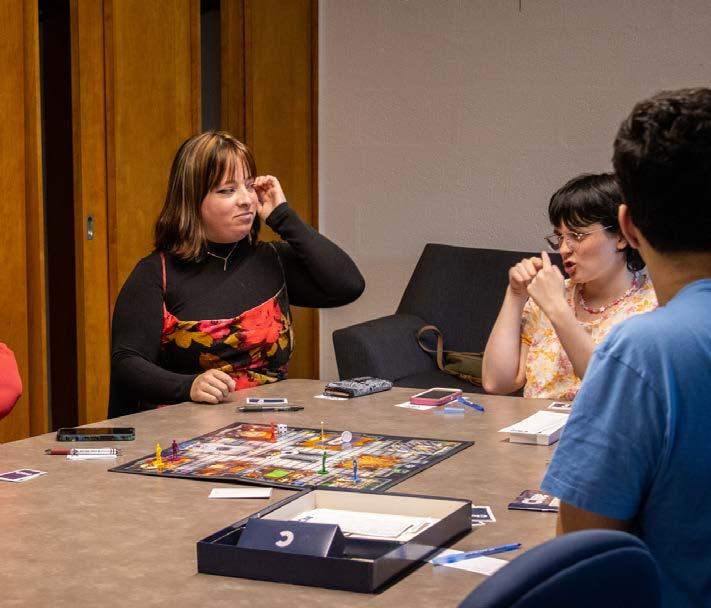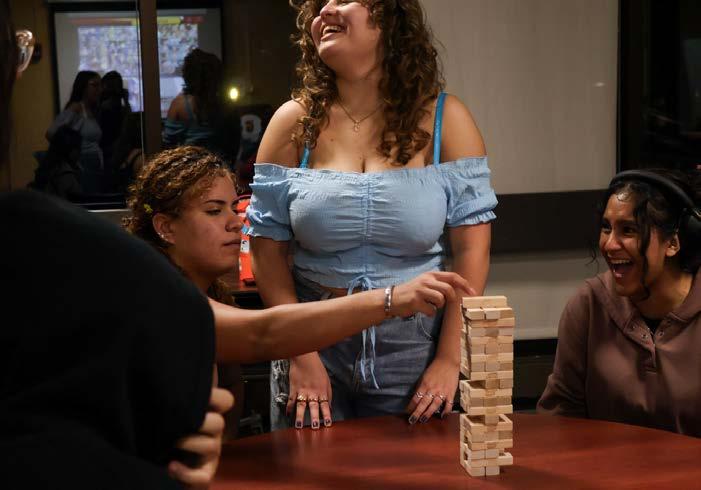
March 14, 2025


March 14, 2025
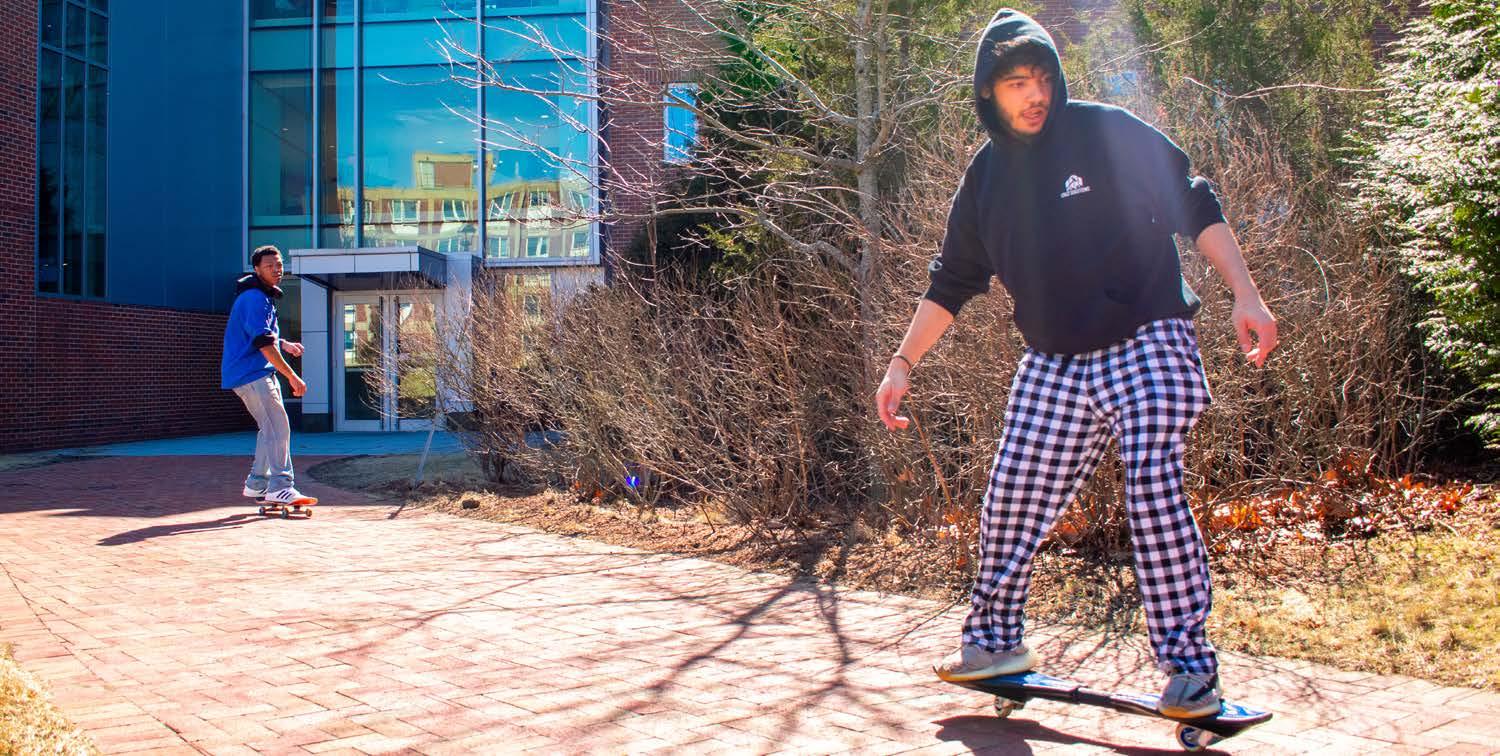
By Sophia Harris Editor-in-Chief
By Dylan Pichnarcik News Editor
Local news anchor Latoyia Edwards will deliver the keynote address at the 2025 undergraduate commencement ceremony May 24.
Edwards is a broadcast journalist known for moderating political debates, anchoring live news events, conducting exclusive interviews, and hosting many charity events annually. In 2023, she was named one of Boston Magazine’s Most Influential Bostonians, according to the University’s press release.
“I am honored that Ms. Edwards has agreed to be Framingham State University’s 2025 commencement speaker. She has been a trusted and celebrated voice in New England for more than two decades, and her commitment to community engagement deeply echoes our mission to empower students to lead within our communities, empowered by their learning and growth,” said Framingham State University President Nancy Niemi. “I look forward to sharing the commencement stage with Ms. Edwards as we celebrate our students’ success!”
Edwards said, “I’ve been thinking about this speech ever since I got the confirmation that I could do it and I can’t wait to talk to the students at
FSU. I think FSU students are uniquely perched and ready to do big things in the world. I love how they are talented and are so smart and down to earth, and I think those are perfect combinations for people to take over the next level of innovation and industry.”
Edwards said she recently enjoyed visiting campus to hear Ndaba Mandela, the grandson of Nelson Mandela, speak on Martin Luther King Jr. Day.
She said she and her family were “riveted by what FSU offers to students. Even just that event alone tells me everything about Framingham State, from the president’s speech welcoming the students, to the student ambassa-
By Sarah Daponde
Asst. Arts & Features Editor
The Center for Inclusive Excellence (CIE) hosted an event as part of their “Diversity Dialogues” series on March 12 to discuss birthright citizenship and the Trump administration’s recent executive order regarding the 14th Amendment.
Joseph M. Adelman and Maria Bollettino, history professors at FSU, were invited by the CIE to lead the discussion of “Diversity Dialogues: Birthright Citizenship and the 14th Amendment.”
“There is a long historical context for everything that is happening today … and having an awareness of that
helps you make sense of what is going down,” said Bollettino.
She said birthright citizenship means someone is entitled to citizenship simply by being born within U.S. territory.
“It’s just the fact of your birth. It’s not a specific identity you hold. It guarantees your rights of citizenship, but also your obligations of citizenship,” Bollettino added.
Adelman then discussed the Trump administration’s recent executive order. “It feels like it was a million years ago, but it was actually 51 days ago,” said Adelman, in regard to when the executive order was issued. It was issued on his first day in office.
The executive order interprets the
14th Amendment differently than it has been interpreted in the past by historians and legal scholars, said Adelman.
The order would revoke citizenship from someone whose mother was unlawfully present in the U.S. or was lawfully present under temporary authorization, and whose father was not a legal citizen at the time of the person’s birth, said Adelman.
Bollettino added, “You’re talking about a group of people who are undocumented - you are talking about a very vulnerable population. And vulnerable populations tend to be the ones that are targeted and scapegoated.”


Editor-in-Chief
Sophia Harris
Associate Editors
Maddison Behringer
Ryan O’Connell
Copy Editor
Emma Lyons
Asst. Copy Editor
Allie Mosher
News Editor
Dylan Pichnarcik
Asst. News Editor
Bella Grimaldi
Opinions Editor
Izayah Morgan
Sports Editors
Izabela Gage
Sophia Oppedisano
Asst. Sports Editors
Taylor Kimmell
Kyra Tolley
Arts & Features Editors
Francisco Omar Fernandez Rodriguez
Owen Glancy
Asst. Arts & Features Editors
Sarah Daponde
Liv Dunleavy
Bella Omar
Photos & Design Editors
Adrien Gobin
Alexis Schlesinger
Asst. Photos & Design Editor
Meghan Spargo
Illustrations Editor
Ben Hurney
Asst. Illustrations Editors
David Abe
Ronnie Chiu-Lin
Emily Monaco
Staff Writers
Jesse Burchill
Raena Hunter Doty
Kristel Erguiza
Paul Harrington
Dan Lima
Antonio Machado
Kate Norrish
Erina Operach
Anthony Pintado
Alexandria Rose
Emma Schor
Anthony Sims
Michael Trueswell
Celia Williams
Staff Photographers
Eliana Buono
Meg Dame
Oné Green
Staff Illustrators
Charlotte Fabrizi
Marcus Falcão
Advisor
Desmond McCarthy
Asst. Advisor
By Sophia Harris Editor-in-Chief
By Sophia Oppedisano Editorial Staff
What is your academic and professional background?
I started at Framingham State in 2019 and started in elementary education as my major. Then I switched to sociology after taking a couple of courses and I really resonated with that. I graduated in 2023 and now I’m currently doing the MBA program here. I just started this past fall, so hopefully, I’ll graduate two years from now. I started out dispatching [at the Framingham State Police Department], and I did that for about a year, and now I am the administrative services manager of the police department. I handle a lot of the procurement side of things - I do the payroll, and I’m also heavily involved in SHAPE, Sexual Harassment Assault Prevention Education, and we are working to spread awareness for sexual violence prevention and education. April is our Sexual Assault Awareness Month, so we’re doing a lot of work on that right now. I manage the ID office, my student workers, and everything that goes along with that.
Why did you come to FSU?
I grew up close by in Holliston, so FSU was always on my radar, so I chose to stay a little bit closer to home.
What are your aspirations after you graduate with your MBA?
I am hoping to continue in the line of what I do with SHAPE, just outreach, and prevention measures. Hopefully, I can get into a position where I can help others with that.
What are your hobbies?
Recently, I got into running. Me and a couple of the officers here used to run after work in the summer. We do 5Ks on Saturdays, and we have one coming up on Sunday - the St. Patrick’s Day 5K - so we’ve been sticking to that. Other than that, I definitely love shopping online and in person. Other hobbies: I just started working in the bakery right down the hall in Sodexo in the mornings. I actually really enjoy baking, and

the baker, Lily, has shown me a lot, so I’m thinking of getting into that a little bit more, too.
What advice do you have for students?
Take advantage of the resources at the school. When I was a senior here, I was very confused about what I wanted to do with a sociology degree. There’s such a wide range of options, but I wanted to do an internship here so I could network more and understand what the workforce is like. When I did my internship with the Dean of Students Office, it opened up so many opportunities for
Elizabeth Banks Monday, March 10. 5:38
Tuesday, March 11. 3:29
Wednesday, March 12. 8:09
me, especially now that I’m still working with SHAPE here. I also worked as a student worker in the police department, too, which helped me with getting the job as a dispatcher when I first started here. So take advantage of the opportunities. Take advantage of CASA and make connections with people. That’s the best advice I can give.
CONNECT WITH SOPHIA HARRIS sharris9@student.framingham.edu
CONNECT WITH SOPHIA OPPEDISANO soppedisano@student.framingham.edu
Wednesday, March 12. 9:56 Trespass Tow Upper Normal Hill Parking Lot Vehicle Removed / Tow
By Bella Grimaldi Asst. News Editor
President Nancy Niemi will hold in-person office hours during the spring semester, according to an email from her office.
Niemi said these office hours are open to faculty, staff, students, and anybody part of the University community.
The office hours do not require an appointment, but the conversations are limited to ten minutes to accommodate more participants. The time can be used to discuss University-related matters, according to the email.
There are three official office hours scheduled for this semester, according to the email.
Niemi said these scheduled hours are held in her office in Dwight Hall.
The first office hour was held on Friday, March 7 from 2:00 p.m. to 3:00 p.m. The last office hour is scheduled for Wednesday, May 7 from 1:30 p.m. to 2:30 p.m., according to the email.
“It was wonderful and any conversation I have as a result of these hours is good - is positive and worth the time it takes to do it,” said Niemi.
There are two informal meeting times scheduled around campus to meet with Niemi, according to the email.
The first informal meeting is scheduled for Monday, March 24 in the McCarthy Dining Commons from 12:00 p.m. to 12:45 p.m. The second meeting is scheduled for Thursday, April 24 from 9:00 a.m. to 9:45 a.m. in the Red Barn Café, according to the email.
Niemi said, “Certainly, I stop and talk to people when I’m out all the time, and at various events, I see people, but this is a nice way for people who want to come in and have a chat about something who don’t normally get the opportunity.
“The idea actually came up independently with me and with my assistant, Katie Hebert, so it was kind of cool,” she said.
Niemi said she was reminded of the concept by a colleague from a different organization.
“I wondered if it was overkill because I try to be out and about anyway, but I thought, ‘Now let’s try this,’ and I brought it up to Katie, and Katie said,
‘You know, I was thinking about the same thing,’ so that’s how we decided to do it,” said Niemi.
According to Niemi, Hebert put together the times and locations Niemi would be available to meet.
Niemi said she wanted to provide the University community another opportunity to talk with her.
She added she hopes to get a broader scope of what people on campus are thinking.
Niemi said students are welcome to make an appointment with her through Hebert if they want a longer time to meet.
“When you’ve got 5,000 people on campus, you don’t get to see everybody in equal numbers. So by having these, I hope that I will see people and talk to people and listen to people more who I would not normally see,” said Niemi.
Niemi added she is pleased with the feedback she has received since announcing her office hours.
She said, “I’m delighted people are excited they have another opportunity to let me know what’s going on. I think it is really important for any community that they know that there are multiple ways to talk to people whose job it is to make sure that their needs are being heard … that they know that they can find me.”
Sophomore Diego Abzun Urrutia said he did not know about the office hours Niemi is holding.
He said, “I think it’s a good opportunity for me or for other students to get close to her or ask for better help in case they have questions they need answers to.”
Junior Josh Gillen said, “It’s a good idea, because if people have concerns, they could go to her and she’ll give it to you straight. She’ll answer your questions. She’s professional.”
Junior Alicia Phillips said she would be interested in attending Niemi’s office hours.
She said in the past, she wanted the opportunity to speak to Niemi about issues on campus.
“She is a very welcoming person and I feel like being able to speak to her would be really good for people who don’t necessarily feel comfortable reaching out to other sectors of the school,” said Phillips.
Freshman David Forgione said he wouldn’t attend unless he had a con-

Sunday night Mar. 16 Rain. Low around 50. South wind 10 to 20 mph, with gusts as high as 30 mph.

Monday Mar. 17
Rain. High near 60. Southwest wind around 10 mph becoming northwest in the afternoon.


Monday night Mar. 17
A chance of rain before 11pm. Mostly cloudy, with a low around 30. Northwest wind around 10 mph.
Tuesday Mar. 18
Sunny, with a high near 55. West wind 5 to 10 mph.
cern about campus.
He said, “I think it’s a smart idea to have the ability to talk to someone like her about what you think should go on around campus and different problems you may be having.”
Freshman Savannah Goba said she would go to the office hours if she had any concerns about campus.
Goba said, “It just makes me feel more comfortable and connected
knowing I have the power to speak with that resource.
“Also, just to know her one-on-one, I’d say it makes the community feel like a good place.”
CONNECT WITH BELLA GRIMALDI igrimaldi@student.framingham.edu
Fri March 7 2:00-3:00pm Tues April 8 9:00-10:00am Wed May 7 1:30-2:30pm

Mon March 24 Thur April 24 12:00-12:45pm 9:00-9:45am Dining Commons Red Barn Café
Dwight Hall 309 508-626-4575 nniemi@framingham.edu & Stay Connected
www.framingham.edu@FraminghamStateUniversity@FraminghamStateU
www.weather.gov

Tuesday night Mar. 18
Partly cloudy, with a low around 40. Southwest wind around 10 mph.

Wednesday Mar. 19
Mostly sunny, with a high near 60. Southwest wind 5 to 10 mph.


Wednesday night Mar. 19
Mostly cloudy, with a low around 40. Southwest wind around 10 mph.
Thursday Mar. 20
Partly sunny, with a high near 60. Southwest wind 5 to 10 mph, with gusts as high as 25 mph.
Continued from Page 1
dors who emceed it, to the awards of changemakers on campus,” she said.
Edwards said, “This is what a college campus is about.
“It is about exchanging ideas, being in a welcoming environment and being on the cutting edge of learning. So that is a telltale sign of awesome learning, and that’s why I’m super excited to be speaking to your learning community,” Edwards said.
Edwards said she is a morning anchor and reporter for NBC10 Boston and NECN. She previously worked as a weekday anchor for WWLP-22 in Springfield.
Edwards grew up in Dorchester and is a graduate of Boston public schools, including Boston Latin Academy.
She earned her degree in broadcast journalism, graduating magna cum laude from Emerson College. She began her career as a news writer for WBZ 1030 AM radio, followed by a reporting role at Fox affiliate WICZ-TV 40 in Binghamton, New York.
Edwards said although her job sometimes seems glamorous, “The last thing I worry about is the glamor part of it. … It’s the truth-telling. It’s the fact-checking, especially in an age where anybody can get on social media and be considered a journalist.”
She said journalists can be sued for “not telling the truth and holding that standard when it’s easy to just be one-sided.”
She added she always tries to be “down the middle, and bringing that to my speech is going to be important to me as well.”
Edwards added that community is something she cares deeply about.
“Community is one of the driving forces of why I am in this position,” she said.
She added, “I feel it’s a personal mission to answer the call as much as I can, to give back as much as I can, be cause that connection, number one, to my viewers in a special way, in a more intimate way, is always great.”
The FSU Commencement Speaker Search Committee was chaired by Dan Magazu, executive director of the Of fice of Marketing & Communications.
Magazu said Edwards spoke at Framingham State during a profes sional development event a few years ago, and “everyone was floored by what a good speaker she was. So she’d been on our radar.”
He said the speech was on “how to be your authentic self.”
Magazu added the com mittee “felt like she would say yes, and we felt she’d be a really inspiring speaker for the students to hear from. So we’re very excit ed about that.”
Peter Chisholm, di rector of gov ernment rela tions, who has served on the commence ment search committee for approximately 10
years, said he is very confident Edwards will be an excellent speaker.
“She’s well known in the region … and I think she is very well spoken,” he said.
Deb Cleveland, who serves as the alumni representative on the committee, said she is looking forward to hearing what Edwards has to say at graduation.
Although Cleveland was not familiar with Edwards at first, “I was very
tried to prioritize community here because we do have a smaller campus.
“She also has good global awareness,” Raeside said.
Senior Gwendolyn Schutt said, “I think Latoyia is a great choice for our commencement speaker. Not only is she a woman of color in a time where the world is trying to regress, but she is also an active community member.”
Schutt added, “Edwards also has a history in the media, which I feel as
“Community is one of the driving forces of why I am in this position.”
-
impressed with her background, and the students that were on the committee seemed to be very interested. I think that’s the most important thing.”
She added Edwards was the committee’s first choice.
Senior Isabella Raeside, who was the student representative on the committee, said she cannot wait to hear what Edwards has to say at her graduation.
though means she is going to put a lot of thought into the words that she chooses to speak. Also, being local gives a community vibe to the people graduating.”
Senior Kaylee Beck said, “I am excited to hear what she has to say. I did not know who she is but after looking her up, she seems very knowledgeable and I am excited to see what insight
they are following and it all happens for a reason!”
Senior Colleen Fitzgerald said, “I hope she reflects on the hard work it takes to get a degree and the trials and tribulations many students have to deal with in order to get to the day of commencement.”
Senior Sofia Wilson said, “I feel good about Latoyia Edwards being the commencement speaker. I know that sometimes, based on things I’ve seen, commencement speakers are sometimes a hit or miss. I did not have strong opinions about who should deliver the speech, but I did care greatly about the person being of good and sound moral character.”
Wilson added, “I hope her speech reflects the resilience of this graduating class. There are so many things happening at home and around the world that can make daily life stressful, but as a class, we pushed through and have made it to graduation, and we have done so by accessing our own strengths and sharing them with one another.
“Everyone in this class is so different and unique, but as a whole, we form a beautiful landscape of important experiences. I hope she shares words of inspiration and strength, of resilience, especially in the current U.S. political environment.”
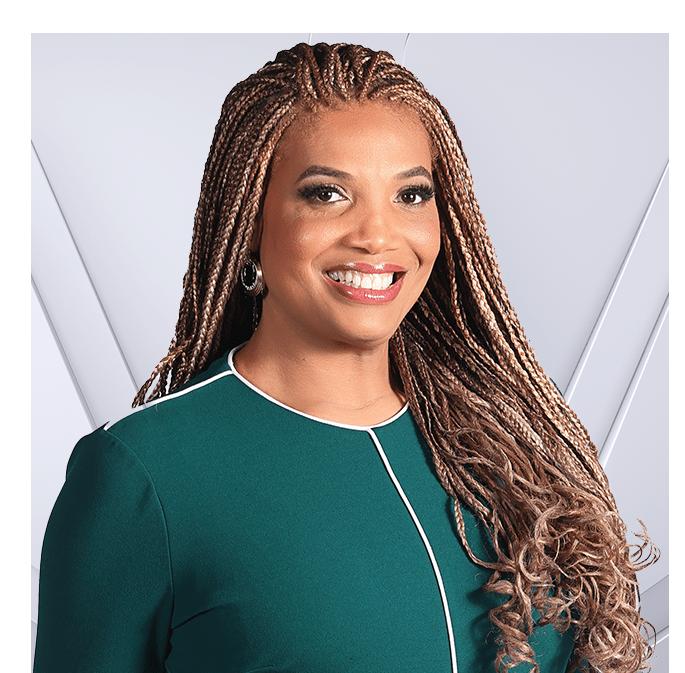
Senior Jeremy McDonald, student trustee, said, “I’m extremely excited to hear Latoyia Edwards speak. I am excited to learn from such an accomplished member of our community. Latoyia Edwards’ journalism has made our community more informed and educated on key matters. I’m excited to hear about her journey and how she achieved her many successes!”
Senior Evelyn Campbell, SGA president, said, “I’m beyond excited to hear Latoyia Edwards speak! Her dedication to community engagement is truly inspiring, and I deeply resonate with many of the values she stands for. As a communications major, I find her journey in broadcast journalism incredibly motivating, and I can’t wait to learn more about her experiences.”
CONNECT WITH SOPHIA HARRIS sharris9@student.framingham.edu
CONNECT WITH DYLAN PICHNARCIK dpichnarcik@student.framingham.edu
By Dylan Pichnarcik News Editor
Student Government Association approved the addition of a code of conduct to the SGA constitution.
The proposed addition was presented by Vice President César Matos at SGA’s March 11 meeting.
Agreeing to uphold the Code of Conduct will be a requirement for all members of SGA for the upcoming academic year, according to Matos.
According to the proposal, the Code of Conduct “promotes accountability,
understand that if in violation, usage of office space can be revoked,” according to the Code of Conduct.
The next section, “Expected Conduct,” states members must agree to be authentic and true to themselves, and choose words deliberately.
The Code of Conduct also outlines a “Violations and Enforcement” category.
Members must agree “any violation of the Code of Conduct shall be subject to review by the Judiciary Committee, which has the authority to issue a formal warning, mandate corrective
of the Code of Conduct to SGA’s constitution, which passed unanimously.
Psychology Club, represented by Club Secretary Bianca Furtado, requested $1,250 for a trip to the Museum of Science in Boston.
A motion to approve the allocation was made by Senator Shawn Brooks and passed unanimously.
ASL Club, represented by Treasurer Priscilla Bonilla, requested $2,000 for DEAFSU.
DEAFSU will “gather all Deaf communities to come to campus. … We want to have tables for them to show
The final funding request was made on behalf of the Haitian Student Association for “Rep Your Flag,” which will be held on March 28 and will cost $6,750. The funds pay for renting a venue located in Boston, DJs, and a photographer.
The event will be a collaboration with M.I.S.S. Haitian Student Association requested $3,000 for the club’s share of the event.
A motion to approve the allocation was made by Brooks and passed unanimously.
During the meeting, senior Anthony

professionalism, and respect. It ensures officers understand their responsibilities, maintain ethical behavior, and uphold inclusivity.
“The code also improves office culture by encouraging work-focused use of spaces and outlines clear consequences for misconduct, ensuring fair and consistent enforcement,” according to the proposal.
The first section of the proposal, “Core Values,” states that members must agree to uphold professionalism and integrity; respect and inclusivity; responsibility and accountability; and representation and advocacy, according to the Code of Conduct.
The “Usage of Office Space” section states members must agree “the use of our office spaces is a privilege, not a right. All SGA members should respect the communal spaces of the office and
action or training, and recommend removal from SGA in cases of severe or repeated violations,” according to the proposed Code of Conduct.
The final category outlines SGA’s “Commitment to Diversity, Equity, and Inclusion (DEI),” which states, “SGA recognizes its responsibility to actively promote DEI within student governance.
To uphold this commitment, SGA shall require all members to participate in DEI training annually, partner with student organizations focused on DEI to amplify their voices in governance, and regularly review policies to identify and eliminate systemic barriers within SGA and the student body,” according to the proposed Code of Conduct.
A motion was made by Senator Alyssa MacDougall to approve the addition
their small businesses,” Bonilla said.
She said the last time DEAFSU was held, 500 people attended.
The allocated funds will go toward catering from Sodexo, a magician, and pens and paper.
Bonilla said interpreters will be at the event, but attendees can also use the provided pens and paper to communicate.
DEAFSU is scheduled for April 26.
A motion to approve the allocation was made by Diversity and Inclusion Officer Ana Julia Riberio and passed unanimously.
ASL club also requested $1,000 for the ASL Ball, which is scheduled for April 11. The allocated funds will go toward food and a DJ for the event.
A motion to approve the allocation was made by Secretary Jazmany Reyes and passed unanimously.
Sims and sophomore Adnan Sajid were appointed as senators by President Evelyn Campbell.
During the club representative portion of the meeting, members of SGA were paired with representatives from student organizations. Matos said this was done to promote networking and communication between clubs and SGA.
Campbell announced the upcoming SGA elections. Nominations will take place during the week of March 31, campaigning will be held from April 5 to April 15, Candidates’ Night will be held on April 6 in the Alumni Room, and election day is April 15 between the hours of 6 a.m. and 6 p.m.
Spring break is a much-needed time for students to unwind after a draining few weeks of studying for midterms and working on essays during long, cold nights.
For many students, it is something to look forward to as the halfway point of the semester.
With FSU’s spring break here, it’s important to remember traveling to spring break hotspots can expose college students to risks.
Travel has always been a significant part of spring break for those who can afford it. For many students, this is their first time vacationing without their families - whether alone or with friends. This is an important milestone and can help them develop necessary skills, such as problem-solving and budgeting.
However, when students travel, especially to distant places such as the Caribbean or even stateside locations such as Miami, their excitement can interfere with their ability to stay safe.
Visiting a popular destination you aren’t familiar with can be dangerous. According to security.org, a University of Miami study found there was a higher number of traffic accidents in popular spring break destinations during the typical spring break period.
According to the study, traffic-accident fatalities rose 9.1% in those destinations. “More fatalities involved out-of-state drivers, and most of those fatal accidents involved drivers under age 25.”
It is important to remain vigilant of those around you who may have been drinking and using substances. Do not get into cars with individuals who may be under the influence. If you choose to consume alcohol, be mindful of your consumption and set limits for yourself.
When drinking in public locations, keep a watchful eye on your drink. Many date-rape drugs, used to roofie drinks, are tasteless and odorless - meaning it isn’t easy to tell if a drink has been tampered with.
According to the Cleveland Clinic, some common symptoms of being roofied are nausea and vomiting, extreme drowsiness, brain fog, and impaired breathing or speaking. If you suspect you or someone you are with has been drugged, drink lots of water,
call emergency services immediately, and do not leave where you are unless absolutely necessary.
Be aware of where you are and who you are with to keep yourself and your friends safe. If need be, have emergency funds set aside for Ubers or Lyfts and always stick with your group.
When visiting places you are unfamiliar with, it is imperative to stay alert to your surroundings. Many traveling students are vulnerable to becoming victims of crime.
Women in particular are often targets of sex crimes while on spring break, whether going to different states or different countries.
Sudiksha Konanki, a 20-year-old University of Pittsburgh student, went missing in the Dominican Republic while on a spring break trip on March 6.
According to NBC News, she was traveling with five friends, but went missing after a beach trip when her friends headed back to their hotel without her. She stayed behind with people she met on her trip and has not been seen since.
The story has shocked students and their families across the country and the search for her has just surpassed one week as the world looks on.
The Gatepost Editorial Board hopes answers are provided soon for Konanki’s friends and family.
Unfortunately, cases like Konanki’s are not unique.
To mitigate risks when you are traveling alone, be sure to inform your friends and family of where you plan to be and when you will be traveling. It could be helpful to have someone text you to check in throughout the trip to ensure you are safe, or to share your phone’s location with someone to keep track of where you go.
Traveling exposes you to amazing experiences and isn’t something you should shy away from - but if you travel, you need to be safe.
Have fun - take part in the excitement and enjoy your independence. Just remember to be vigilant and look out for each other.
By Sophia Harris Editor-in-Chief
We have all been there.
Skipped class and forgotten to tell your classmate.
Taken something out of your sibling’s room.
Used an excuse to cancel plans that maybe wasn’t completely true.
This feeling that starts in your chest and crawls up the back of your throat to invade any quiet space in your brain.
This feeling is called guilt.
It tends to bubble up when you do something that goes against religious, moral, or cultural values. This is not a new feeling for us. The National Institute of Health states that complex self-conscious emotions, such as guilt, may be experienced as early as 2 or 3 years of age.
Guilt, in many ways, is a byproduct of the culture in which we live. We’re constantly told we should be doing more, achieving more, and being more - for others and for ourselves.
In this environment, failure isn’t just seen as a setback - it’s often perceived as a character flaw. There’s little room for a mistake, no space for the grace we all need to simply be human.
Guilt is not inherently bad. It shows you have a conscience and some part of you may regret what transpired. This justification might look different for everyone. While we can all agree that cheating is bad and donating to charity is good, there is a gray area within every scenario which is where the difference in perception kicks in.
The problem, however, arises when we mistake guilt for moral purity.
It’s easy to fall into the trap of thinking feeling guilty automatically makes us “good people.” But that’s not the case.
Simply “feeling bad” about something you’ve done doesn’t get rid of the harm caused. What I argue is that it’s not about your guilt. Just feeling guilty does not make you a good person.
Think about it: how many times have we heard, or even said to ourselves, the following:
“I feel bad.”
“I’m sorry you feel that way.”
“I’m sorry.”
These words, though well-intentioned, are hollow if they are not backed by genuine reflection and action.
The truth is, your guilt doesn’t purify you.
You can’t apologize just because you feel bad about what happened. Apologizing for your own emotional relief isn’t the same as making amends for someone else’s pain.
True accountability doesn’t come from simply expressing regret. It requires action. It’s about acknowledging what you did and making a conscious, earnest effort to change your behavior.
Apologies, when they truly matter, are not delivered through a text or a passive “sorry.” They require a face-to-face conversation with the person you’ve wronged - a conversation in which you take full responsibility for your actions and listen to the other person’s feelings without defending yourself or minimizing their hurt.
You have to consider other perspectives because forgiveness is the antidote for guilt. Guilt should be a motivator for you to change your ways, not for you to feel better. And the way to do that is to first acknowledge, fully, what you have done and make a conscious effort to apologize for your actions or lack thereof.
But here’s the catch - even after you’ve acknowledged your wrongs and offered a sincere apology, forgiveness doesn’t lie with you.
You can’t demand forgiveness, and you can’t expect it immediately. It’s not up to you whether the person you’ve hurt forgives you.
That is entirely their choice. And if they choose not to forgive, that doesn’t absolve you of the guilt. Instead, it’s an opportunity for deeper growth and reflection.
Guilt is a powerful tool for self-improvement - but only if we use it wisely. It should motivate us to change, not to soothe our own discomfort.
If we let guilt sit as a lingering feeling without seeking to amend our actions, we only trap ourselves in a cycle of regret without progress.
Instead of letting guilt fester, let it serve as a catalyst for growth. Use it as an opportunity to reflect on how you can be better - not just for your own peace of mind, but for the people you impact.
In the end, guilt is not about feeling bad - it’s about doing better.
In a world that constantly pressures us to achieve, to be perfect, and to never fail, guilt reminds us that we are human - and that’s OK.
What matters is how we respond to it.
Are we willing to use our guilt as a stepping stone toward change? Or will we allow it to paralyze us with regret?
Use your guilt to grow.
By Alexis Schlesinger Editorial Staff
It is completely baffling that so many people around me lack the ability to recognize the way a multitude of personality traits make up human beings.
They are unable to comprehend that people are not defined by one thing you dislike about them, or one opinion they have that you disagree with.
Overall, we are living in a plague of thoughtlessness.
There is apathy toward wanting to learn, understand, know, listen, hear, empathize, comprehend, or appreciate the people around us.
There is such a complete inability to pull apart people’s personalities, that it is often assumed that getting questioned is an attack, rather than someone trying to learn your perspective.
You know you can look at a complete puzzle, take it apart, and put it back together again, right?
You can take one piece out, examine it, and put it back where you found it and recognize its place in the completed puzzle.
All of the pieces exist regardless of whether the puzzle is complete or not.
Think about the middle points of completion, where you have a few chunks of the puzzle put together, and you see them as small groups - you slowly add on to them until it all connects.
One puzzle piece is technically an image. It has edges. There is a “completed” image because it is contained inside the shape of the piece.
It has boundaries that contain something.
But it’s really not meant to be a complete image. It is made with the purpose of creating a larger image. The bigger picture.
The whole person.
You must get comfortable with contradictions being presented.
Get comfortable with them in every way they could possibly be present in your life. Get comfortable with contradicting others. Get comfortable with contradicting yourself. Get comfortable with being contradicted. Get comfortable with the fact that some people have personality traits that contradict other traits they possess.
It is a gift.
The contradictions you find are a gift of a new perspective.
Once you look at things in multiple ways, you will realize multiple views, ideas, perspectives, points, thoughts, opinions, theories, or conclusions can be true.
Or you can decide you only believe one to be true.
You don’t have to like contradictions. You don’t have to agree with contradictions. You don’t have to change your mind when you get contradicted.
You don’t have to be confident in your ability to contradict others either. It’s OK to be nervous.
Contradiction causes conflict because so many people assume that a contradiction to one view, idea, perspective, point, thought, opinion, theory, or conclusion contradicts them all.
But contradictions are going to happen.
Accept that contradictions exist.
In “Song of myself, 51,” by Walt
Whitman:
“Do I contradict myself? Very well then I contradict myself, (I am large, I contain multitudes.)”
I have a huge problem with the lack of critical thinking displayed by people around me.
And I am not only talking about people my age, or the generation fol-
get along with better - people who contradict you less - earn an award, present an A+ project, get promoted, get into a happy relationship, get accepted into their dream school, enjoy the same thing as you?
I am not perfect. I contradict myself. I contain multitudes.
So, I know that everyone contains
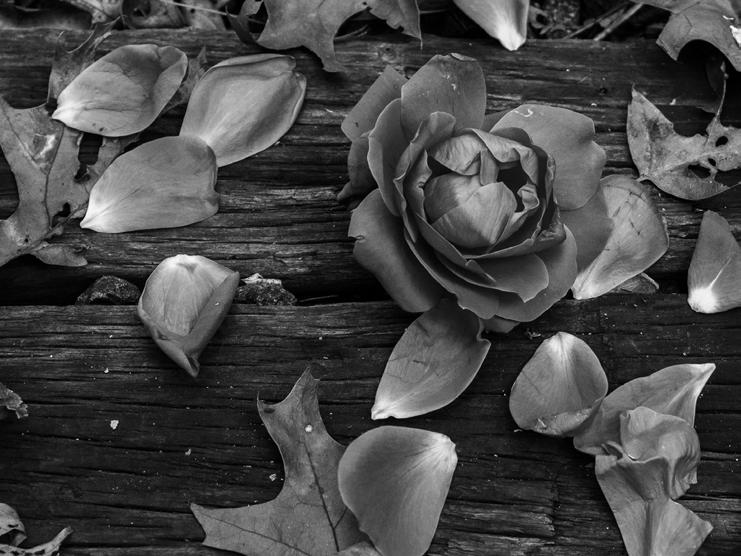
lowing. I am talking about everybody who exists right now.
You might think you are an empathic person. You might think you are thoughtful. You recognize others for their achievements. You uplift your community members. You’re a good listener, and you’re kind, and you always know what to say.
You might be.
I believe you are.
But what about that kid in your class who is “actually the worst” because they have a different interest from you and talk about it too much? When would anyone ever need that information?
Do you clap when they earned an award, or do you wonder how they could’ve possibly received it over someone else? After all, the skills they applied to complete their “groundbreaking project” were so niche, they were the only person who ever talked about it.
Or that person in your group project whose ideas you thought were “way too complicated” - they offered to do it all themself but it doesn’t really need to be that deep. You just need to pass the class and move on - why should you have to have to present a complicated project just because someone else wants to?
Are you impressed now that they have switched into a different group who admires their idea and gives them the space to get it done, or do you still hate the idea because they’re way more invested in the class than you are?
Your coworker is a “total suck up.” They do extra work, pick up extra shifts, and offer to do tasks that aren’t required of them. Whenever you see them around they try to chat with you. You’re just coworkers, you don’t want to be their friend. What an inconvenience to tell them how your day went every single time you see them outside work.
Are you happy they got promoted? Do you think they’re qualified? Or would you rather someone you
It could be started by one small thing happening to me, one sentence spoken to me, one act of kindness or malice toward me or someone else I might know. It sparks infinite connections.
Multitudes.
Puzzle pieces.
I examine them as separate events, people, words, actions, and then put them together to form a completed image.
Every piece connects to another, so the puzzle can always get bigger.
Like any puzzle, there are pieces that don’t connect unless there are certain pieces in between them.
But there is always a way to do it if you look long enough.
If you look for a different solution.
Connection is always possible if you work hard enough to make it.
What I’m saying is, I know that my unsavory traits are separate from my most easily digestible or pleasant ones.
And I know this to be true of all people.
So despite the way some people have mistaken one word, action, phrase, event, trait, opinion, multitude of mine to be my entirety - I still know that my negative interactions with them are separate from their positive aspects.
multitudes, contradictions.
Multitudes of contradictions even.
So while I am sometimes frustrated, abrasive, angry, jealous, annoyed, upset, offended, argumentative, or contradictory, I make an effort to think about the multitudes of others.
So I have a multitude of opinions on you.
I have a multitude of opinions on people I love, like, dislike, never get along with, disagree with, barely know, admire, or collaborate with.
There are people I am incredibly close with and love very deeply, but I don’t work well with on school projects.
There are coworkers I’ve had who were very reliable and always friendly to me at work, but were impossible to talk to outside of our workplace.
There are people who I barely know aside from following them on social media and I admire their accomplishments.
There are people who have been unkind to me, and I dislike the way they’ve treated me.
I find their words, actions, messages, rumors, mistreatment, ignoranceunfair.
Yet, I can recognize, and must recognize, they are parts of them I find to be positive traits.
Traits I would look for in a partner, friend, collaborator, boss, community.
They are hardworking, passionate, fiery, humorous, sensitive, intelligent, creative, authentic, bold.
In the spirit of every article, metaphor, analogy, symbolism, sentence within this article I have written, I must acknowledge there is no one particular person I refer to here.
I am always inspired by multitudes of people and their many actions.
However, there is usually one event that will trigger the inspiration of one of my OP/EDs.
But it all connects. There are so many people, so many events in my life I have gone through that I draw inspiration from.
Maybe not in every moment. That would be impossible.
But when I remember, I take the time to separate the piece or group of pieces I don’t find pleasant, so I can admire the ones I do.
If it is one small thing it doesn’t take much effort.
A more complicated, contradictory person may take longer to separate. If I have had experiences with them that I have found unkind, unpleasant, rude, unfair, condescending, mean, or scary, those pieces can be overwhelming. They take over the positive multitudes.
Sometimes all I can look at are the puzzle pieces they have shown methe ones that make me feel less than myself - almost as if the imagery might leap from the cardboard vessel that allows it to be tangible.
But there is at least one piece, somewhere, within their puzzle that would not contradict the shapes of my own pieces.
There is a piece of them that aligns with me, if I take the time to look hard enough.
The infinite multitudes of our personality traits exist all at once in every moment.
Really I think any person’s brain would explode if you tried to comprehend every piece of someone’s existence all at once for every moment. Comprehending someone’s whole existence implies that you have looked at every multitude, and how they combine to make bigger and bigger pieces of that person until you come to their whole self.
So there is no pressure for you to understand me or anyone else all of the time.
But you should try a little harder to comprehend a little more. Take some time to separate your observations about me.
Do I contradict myself?
Very well then, I contradict myself.
I am large.
I contain multitudes.
“What are your plans for spring break?”
By Maddison Behringer, Associate Editor and Emma Lyons, Editorial Board
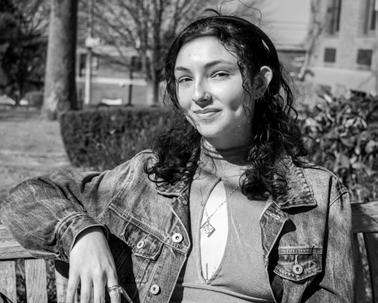
“Mainly just to relax. I don’t have any set-in-stone plans.”
- Susanna Krantz, senior
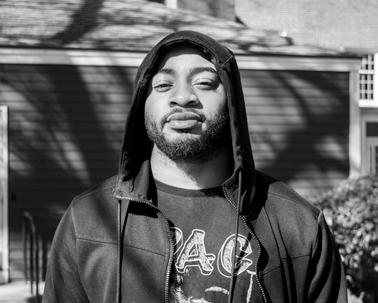
“I’m going home to New Jersey.”
- Elijah Nichols, senior

“Just
to work a lot - try to get more money and save it.”
- Amelia MacDonald, freshman

“We plan on going to Puerto Rico. We’re staying in [Fajardo]. We’ll be there for about five days.”
- Minely Cardozo, senior and Angelina Anderson, junior
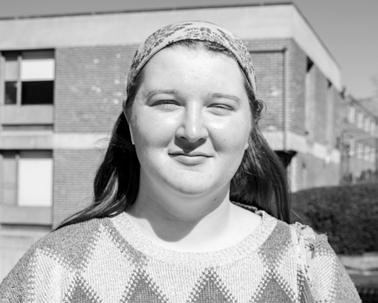
“I actually plan to catch up on a lot of missing assignments and honestly just focus on getting myself recovered from this semester so far.”
- Autumn Ray, junior
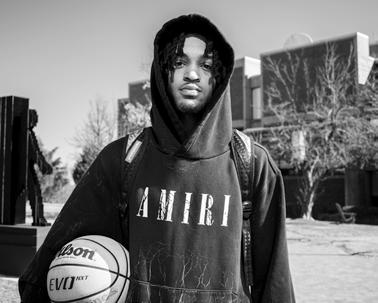
“Probably go chill with my family.”
- Ja’Mari Toneysimmons, freshman

Scores five goals in fourth period
By Izabela Gage Sports Editor
The women’s lacrosse team defeated the Wheaton College Lyons 10-7 in their home opener March 9.
This win brings their early-season overall record to 1-2.
After losing the MASCAC Championship game last year, the team is hopeful for redemption.
Goalkeeper Bella DiMare, a junior, said the experience was heartbreaking but also “a huge motivator for us. Our main goal is to get back there and finish the job this time. We know we have the talent and work ethic.”
Attacker Maddie Bosma, a freshman, said the team’s biggest goal is to make a statement in the postseason. “We know we have the talent and chemistry to compete at a high level, so it’s about staying focused, improving every game, and playing as a unit.”
She added, “It’s really motivating to come into a team that had so much success last season. Knowing that they made it all the way to the championship game makes us want to work even harder to get back there and win it this time. There’s definitely a high standard already set. … It pushes all of us to give our best effort every day in practice and games.”
At the start of the game, midfielder Kelley Debellis and Wheaton’s Gabs Smart lined up at center field for the first draw.
Despite Wheaton taking possession of the ball, Framingham did not relent, and less than 2 minutes into the game, Captain Molly Lanier, a midfielder, netted the first goal of the game.
Debellis won the next draw, and Lanier found her way back to the net once again, but shot wide.
Attacker Alessia Lye picked up the ground ball mere seconds before defender Lindsey Cox was given a green card, giving the Lyons possession of the ball.
Framingham received another foul 47 seconds later, and Wheaton took advantage of a free position shot to tie up the game 1-1.
The Rams didn’t wait to take the lead back. Twenty-four seconds later, attacker Hailey Baker positioned herself behind the goal and passed the ball to Debellis, who sent the ball to the top left corner of the net from the 8-meter arc.
Defender Kaleigh Houlihan caused a turnover by Wheaton, but Framingham unfortunately lost possession soon after, and Wheaton was able to tie up the game.
Captain Leah Green, an attacker, and Emma Kendzulak, a midfielder, both tallied shots on goal, which were saved by Wheaton’s goalkeeper, Jenna Langan.
With another Wheaton turnover caused by Lanier, Houlihan picked up the ground ball and ran it downfield into the offensive zone. Lanier took
another shot in hopes of finding the back of the net for her second time, but the shot was wide.
The first quarter ended with a ground ball pickup by Baker, but the Rams were unable to set up any offensive opportunity before the clock ran out.
The Lyons won the first draw control of the second quarter, but Houlihan caused another turnover, and Debellis grabbed the ground ball.
After attempting to find an opening on the net, the ball was sent out of bounds, giving Wheaton possession.
At 10:56, defender Lily Malloy, a freshman, earned a free position shot that was saved by Langan.
The Lyons then had the ball in their control, but a turnover returned it to the Rams, with Baker picking up the ground ball 14 seconds later and netting a goal to take the lead 3-2.
Bosma widened the lead to 4-2 with her first NCAA career goal after a turnover caused by Houlihan.
Framingham did not let up on offense, with Lanier taking a shot on goal that was saved by Langan, but Green picked up the ground ball.
Langan stopped her next shot, but was unable to hold off Green’s relentless offense as she made another attempt to net the ball and finally broke through Langan’s defense.
The Rams ended the second period with one last shot from Debellis that was stopped by Langan.
Lanier gained possession for the Rams after winning the first draw in the third quarter.
After a turnover by DiMare, the Lyons tried to close the point gap but could not find a way past DiMare’s defense.
A minute later, Wheaton remained in the offensive zone and was able to score their third goal of the game.
The Lyons did not let up and found the back of the net again to close the deficit to only 5-4 in favor of the Rams.
Both DiMare and Langan remained attentive, and each stopped all five shots sent toward them before they reached the goal line.
Debellis once again won the draw control at the start of the fourth quarter.
After both teams fought for the ground ball, Lanier finally picked it up and sprinted down the middle of the field before sending a shot to the left side of the net, bringing the score to 6-4.
Only 40 seconds later, Lanier found the back of the goal once again to extend the Rams’ lead to 7-4.
Despite the Rams having a 3-point lead in the fourth quarter, Lanier’s contributions didn’t end. Less than 2 minutes later, she netted her third goal of the quarter, assisted by Baker.
Wheaton tried to keep up with the pace and sent the ball into the goal past DiMare into the net.
After 4 turnovers from the Rams
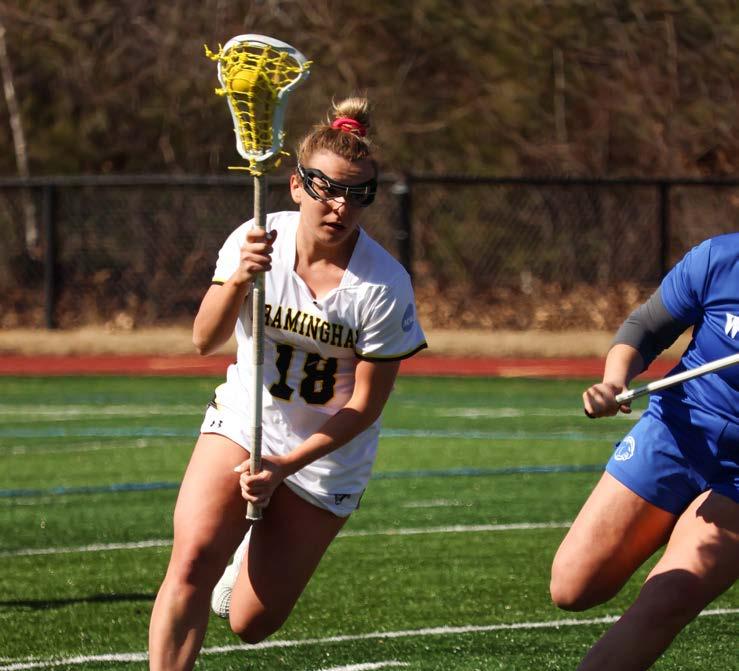
Adrien Gobin / THE GATEPOST
Molly Lanier cradling the ball in win against Wheaton College March 9.
and 2 from the Lyons, Kendzulak netted her third NCAA career goal in her first three games played as a freshman.
The Lyons were still determined despite the end of the game nearing closer and were able to slip the ball past DiMare’s stick.
With only 45 seconds left in the game, Bosma brought the Rams to a double-digit score, netting her second career goal and ending the game 10-7.
Lanier said, “With a low-scoring game, we are working on finding more ways to magnify our strengths on offense and use everyone’s specific strengths to our advantage.”
DiMare tallied 12 saves on 19 shots on goal. She said she has been focusing on “staying composed in the net and making sure my communication with the defense is strong.”
In the Rams’ 14-10 loss against the Plymouth State University Panthers March 5, Lanier contributed 2 goals and reached 100 NCAA career points.
Lanier said she tries not to look at her stats but remains “focused and determined” to help the team succeed.
She added, “I had no idea I was going to hit it so soon, so I was super excited about it.”
Lanier said, “I can’t thank my teammates enough because without them, I wouldn’t have been able to have as much success in the record books as I have had.”
Houlihan and Lanier were named MASCAC Defensive Player of the Week and Offensive Player of the Week, respectively.
Houlihan said, “It’s a recognition of the hard work and effort I’ve put in, but it also pushes me to continue improving. Knowing that I can make a significant impact on the field encourages me to stay focused, keep building on my skills, and work even harder for the team.”
Lanier said going forward from receiving this accolade, “I’m super excit-
ed to see what’s coming next. Without my teammates, I wouldn’t have been able to score or do anything offensively.”
DiMare said she is impressed with how the freshmen are adapting. “It’s always an adjustment coming into a new environment, but they’ve been eager to learn and bring a lot of energy to the team.”
Houlihan said, “Transitioning into college sports is always a challenge, but they’ve demonstrated great effort and intensity.”
Lanier said she can’t explain how proud she is of the freshmen on the team. “They have been placed under a lot of pressure with huge roles to fill as we lost key players in the last senior class. The girls have truly stepped up to the challenge and are working their hardest to do well.”
Bosma said, “The speed and intensity of the college game are definitely a step up from high school, but the upperclassmen have been really supportive in helping us make that transition.”
Most recently, the Rams fell to the Eastern Connecticut State University Warriors 13-6 on March 12. Their overall record is now 1-3.
The Rams are back in action when they travel south to Panama City Beach, Florida to face the Colby-Sawyer College Chargers March 17 and the Endicott College Seagulls March 19.
DiMare said, “Our first few games showed us what we need to work on, and we’re making adjustments to our game plan. Florida is a great opportunity to build momentum, so we’re making sure we’re prepared both physically and mentally.”
Stats sourced from fsurams.com and MASCAC.com
CONNECT WITH IZABELA GAGE igage@student.framingham.edu
By Kyra Tolley Asst. Sports Editor
Senior student-athletes epitomize university pride, having dedicated themselves to years of representing their school in athletics while simultaneously getting a college education.
Whether they are waking up early for practice, going to classes, rallying for games and races, or bonding with their teams, student-athletes have a lot on
Kaylee Beck
Field hockey Captain Kaylee Beck’s future looks bright, with a master’s degree to be completed in the next three years.
Beck began playing field hockey in seventh grade and said, “It’s what I’ve always turned to if I feel stressed or I feel mad or I’m upset - I just go work out.
“That’s who I am as a person for the most part. I feel like it always gave me something that if I didn’t want to push, I pushed for my team. I was trying to get better for them, not just for me,” she added.
Playing in the 2024 season wasn’t always a given for Beck. She said, “I got injured last spring, and I messed up my ankle so badly. I thought I wasn’t going to be able to play my senior year, so especially after that, it was like everything I did, every rep I took, was 110% no matter what.
“If you’re not going to do that, then what’s the point of doing it at all?” Beck asked.
Luckily, her senior season gave her
Football Captain and quarterback EJ Nichols hopes to help kids learn how to play football after graduation. When it comes to his future, Nichols has a lot of options on the table.
their plates.
Despite their busy schedules, collegiate athletes maintain a sense of joy for their sport and tackle a unique set of challenges every day.
For some student-athletes, this chapter is coming to a close, while others are planning on continuing to play, but for the following fall and winter Framingham State University seniors, a new phase of life is just beginning.
personal success. Beck played for her Senior Day game and said a highlight of her career was scoring the overtime goal to win the game.
She said after scoring the goal, the first people she saw were her family members and that celebrating with her teammates was a special moment.
“If I could go back to any day, every single time, it would be that one,” said Beck.
Her post-graduation plan of continuing her education is something she feels lucky to be able to do. Her master’s degree will be in applied behavioral analysis and she hopes to help kids with behavioral issues.
Despite her academic ambitions, Beck doesn’t plan on leaving the sport behind completely. She said she wants to coach in the future, too.
Beck said, “There’s something about being in an athletic setting that just changes my entire demeanor. Whether I’m watching it, playing it, coaching - it doesn’t matter. I love it.”
The community Beck has built while in college is something she feels will be difficult to maintain, but she knows
Whether it be continuing to play elsewhere or finding a place to coach, he has set himself up for success.
Nichols started playing football at the age of 6 and said his first memory of playing the sport was when he threw a football for the first time and saw the


who she can rely on after graduation. “I lean on the people I love, and I lean on God. Those are really the only two things I need to carry me for the rest of my life.”
Beck said she thinks playing sports and getting a college education at the same time is what helped her succeed academically.
The busy schedule Beck had as an undergraduate was helpful and she will continue that in her master’s program by simultaneously working 40 hours a week.
She said, “Going into the career I’m going into and working with the mostly non-verbal autistic children I’ll be working with for the next three years, they need to know that the person that’s in their corner is going to advocate for them, and they’re going to be safe around them.
“They want to have fun and I feel like field hockey and being an athlete in general, and being given those leadership roles, has almost steamrolled me the perfect path in order to go do what I’m going to do,” she added.
Beck said not being an athlete any-
reaction of the parents around him.
He said his favorite part of football is encouraging people. “Being in a leadership role, you have to get the best out of your teammates. … I found joy in that and competing.”
What Nichols said he will miss most are “the little things” - bonding and being in the locker room with his teammates.
“In college, you’re around your teammates and your friends all the time, so if I were to play somewhere else after this, it wouldn’t be the same.
… The brotherhood is the biggest thing that I will miss,” Nichols said.
He said, “We talk about how when we’re older, our kids are going to play with each other. … I think we’ll stick together.”
Nichols emphasized that football has consistently been the main part of his life and something he “could always hold on to.”
The biggest lessons Nichols said he learned from playing football are, “When you fall, get up,” and to learn how to lose.
In Nichols’ time at FSU, he contributed to two MASCAC Championship wins as a wide receiver, an achievement he said he came to college wanting.
Nichols said getting an education while being an athlete was stressful. “It’s great if you know how to manage your time and if you can exert the right
more will be difficult, but she believes she has mentally prepared enough for graduation that it won’t be as difficult as others might think.
As a teenager, Beck said she saw her older brother, Christian, who played basketball for much of his life, not be able to play anymore due to health issues.
Beck said, “I always looked up to him as not only my brother, but he was my hero. I always wanted to be an athlete like Christian Beck. … That’s what I aspired to be.”
She said that seeing what her brother went through helped her find that while she loves her sport and sees it as an outlet, it’s not her entire life.
During Beck’s time playing in college, she described herself as a ‘come with me’ player.
She said a ‘come with me’ player is a teammate who invites other members of the team to tag along with them. Whether it be to the mall or to the dining hall, she advises other athletes to always extend an invitation.
amount of energy in both, then it’s a great experience.”
The leadership advice Nichols received from his coaches and his experience as a captain is what he said has prepared him for his next step in life.
He said the different personalities he has played with over the years have taught him how to work with people and he thinks this will translate into his future job working with kids.
Nichols aims to instill confidence in young players to be able “to do whatever you need them to do to help the team.”
He said his football journey isn’t quite over yet, but he wants to find his “next purpose.
“That’s why I say I want to help kids because I feel like if I couldn’t make it to the top, then at least I can help somebody, and that will fulfill me,” Nichols said.
In terms of advice for younger student-athletes, Nichols said using your resources is important. He said to use “CASA, talk to your advisors, get familiar with your professors, and whatever sport you’re in, make sure your coach knows you.
“Build good habits, find good people, a good friend group, and stay on the right path - stay focused,” he added.
Continued from Page 10
Bryce Borletto-McCray
Men’s soccer Captain Bryce Borletto-McCray has played soccer for the past 20 years, starting at the age of 3.
He said he has plans to continue playing soccer for a semi-pro team in New Hampshire and also has a coaching opportunity lined up.
Borletto-McCray said, “I’m going to be coaching youth soccer for now and obviously, the goal is to see how far I can take that.
“I know my abilities and my commitment isn’t there as much as it used to be and I’d like to put it into coaching and make youth soccer as fun as it was for me,” he added.
He reflected on his years of playing U10 soccer and the teammates he has maintained friendships with for all these years. “Those were probably my most favorite days,” Borletto-McCray said.
He said soccer has been a huge aspect of his life because of the year-
Megan McAuliffe
Women’s soccer Captain Megan McAuliffe aims for a role as a teacher in the future, but looks fondly on her days of playing soccer.
Beginning the sport at the age of 3, McAuliffe said she was a defender early on and that being part of a team is an aspect of athletics she has loved
round schedule. “I feel like it’s literally been my entire life.
“My mom always jokes that I live and breathe soccer. There’s nothing else I do. I watch soccer on the weekends if I’m not playing soccer,” Borletto-McCray said.
He said both high school and college game days are events he misses.
He said his team’s sense of community came naturally. “Especially my first three years of college, I was always with my team - I never got tired of them. I literally spent night and day with them, and just had a great time,” Borletto-McCray said.
He said while his senior season didn’t go as planned, the first three years of his collegiate career were “something special.”
Borletto-McCray said his grades were better during soccer season and being a student was “so much easier” when he had practices and games to go to.
He said his professors were understanding and helpful when it came to missing classes for games and making up assignments later.
from the start.
“I’ve always had the best girls on my team. They’ve always supported me on and off the field. It’s just a sisterhood,” she said.
Missing her teammates and the “tight bond” she has with them is something McAuliffe said will be hard after graduation.
Making it to college-level soccer is
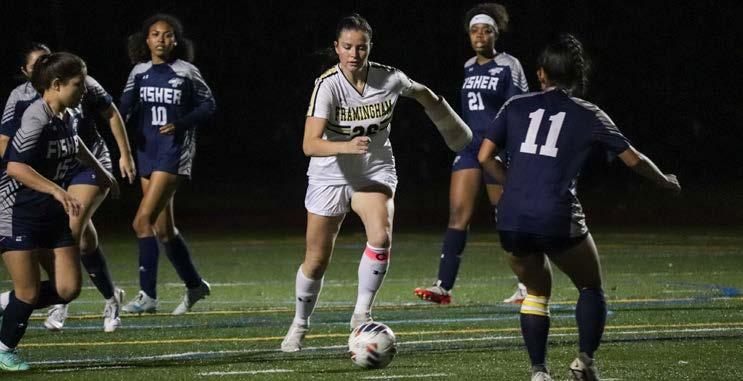
Men’s cross-country runner Ben Hurney ran competitively for three years in high school and returned to the sport for his final two years in college.
Hurney said cross country has had a “pretty big impact” on his life due to all of the friends he’s made through running and the meets he’s enjoyed.
“I really liked the Mass. Maritime meet this year. It was fun setting up by the bridge and running on the canal, which is something I could do, but not in the same way,” he said.
There isn’t an end to running for Hurney. He said after graduation, he wants to continue running and make more time for it by finding a better schedule.
During his time at Framingham State, being a student-athlete actually helped Hurney. “I feel like cross country helped give structure, like eating three meals a day and getting up early-ish for class.”
Hurney said not stressing too much
The lessons he has learned in his time playing collegiate soccer are to never take anything for granted and there’s always room for improvement.
Borletto-McCray said his advice to freshman student-athletes would be,
and listening to his body are lessons he learned from cross country. He said, “It’s hard to know when to run and when not to run,” but to “go with your gut.”
Hurney said there are multiple advantages to running, including help with being “anxious or irrational.
“I just feel like my head space is better in phases of my life when I am running, but it’s also just a nice community, and it’s good for you,” he said.
A key moment Hurney remembers from his career was running the New York Marathon in 2023. “I felt pretty good for the most part - for the first half, at least, but it was very fun.”
Memories aren’t all Hurney has to rely on - he has lots of videos of that day. He said he’s excited to revisit those videos at some point in the future.
Hurney said his participation in the New York Marathon was his priority during his junior season, so he didn’t feel as much pressure to be competitive, but he still put in the effort to pass the competitor in front of him
“Don’t entirely focus on sports. Sports are definitely important … but also focus on your grades because that is important because if you don’t get that, you can’t play.”
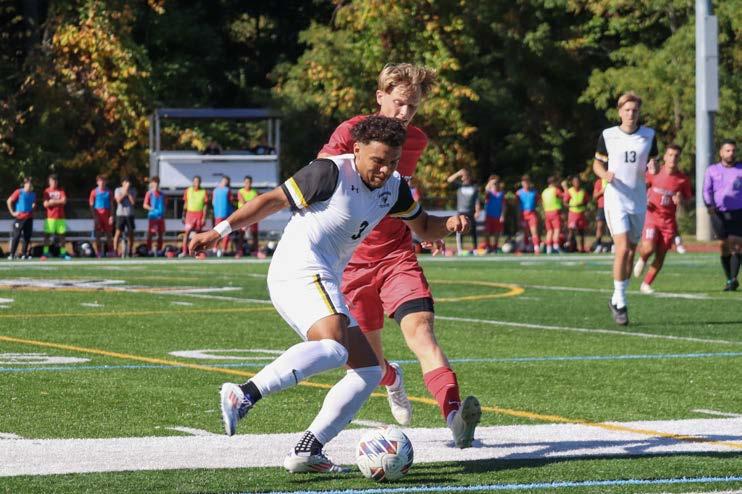
a marker for how important the sport has been throughout her life, McAuliffe said.
“It was something I didn’t want to ever say goodbye to. … It’s been a part of me for so long, and there are so many things that I’ve given up to play. It’s just crazy that it’s over now,” she said.
McAuliffe said getting an education while being an athlete was “definitely hard, but I’ve been a student-athlete my whole life, so I wouldn’t really see it any other way.”
McAuliffe’s ambition for post-graduation knows no bounds. She said, “I just got accepted to the Merrimack College fellowship program so I’ll get my master’s in moderate disabilities.”
The fellowship will completely fund her master’s education, said McAuliffe, and after that, she plans on teaching wherever she can.
This semester, McAuliffe is a student teacher for fourth-grade students at a school in Ashland, she said. “Even when I have tough days and I don’t necessarily want to get up and go, my
during cross-country races.
Hurney emphasized that cross country is a team sport and said being friends with his teammates is part of being an athlete. “There’s a bond there of just having gone to practice every day.”
Hurney explained the importance of knowing when to rest. He said, “I feel like the mental side of it is obviously a big part of it, but it’s so much more than you expect.”
Hurney said he would like to work at FSU at some point after graduation, but he also wants to write a musical and already has an idea.
His advice to freshmen athletes is if you’re “not enjoying it, take a step back. You’ll probably be better at it by doing that, or you’ll be happier, so it’s a win-win.”
Hurney said he appreciates how understanding Head Coach Mark Johnson and Assistant Coach Glenn O’Connor have been of him being busy with both school work and club membership and he is thankful for the team he’s been running with for the past two years.
kids make it worth it,” McAuliffe said.
Using the teamwork skills she learned from athletics, McAuliffe is able to contribute in group settings while teaching.
She said, “At the school I’m working at right now, I’m working with a fourth-grade team that works together so seamlessly. Everyone has a job and everyone gets the job done.”
McAuliffe drew similarities between her love for teaching and her love for sports. “I’m always everyone’s number one fan on the field, so I like to be my students’ number one fan as well.”
Having been an athlete her whole life, McAuliffe said moving on from soccer is hard to think about.
“I’m trying to see the positives in it and doing things more on my own terms, but I know I’m going to have to sign up for workout classes because my team is what motivates me in everything I do,” she said.
One piece of advice McAuliffe lends to freshman athletes is, “Make Framingham State better than you found it. … Leave a legacy behind.”
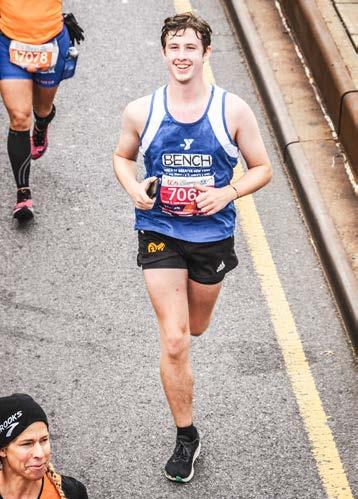
Continued from Page 11
Katie Haselton
Women’s basketball Captain Katie Haselton started playing basketball at 5 years old and has been on an upward trajectory ever since.
Haselton played on many teams growing up, but her transition from middle school to high school basketball was particularly impressive. She went straight to varsity in her eighthgrade year and also played for AAU travel teams.
Her skills helped her break 1,000 career points in high school. “My name is currently on Greenfield High School’s banner, and I finished with 1,438 points,” Haselton said.
Haselton said she started playing basketball at a young age with her dad and brother in their driveway.
Haselton said there’s a lot she loves about the sport, but the friendships she’s made are the most important and “will go on past the game of basketball.”
Men’s basketball player JD Okafor began playing when he was 11 years

Men’s ice hockey Captain Ashton Collazo was introduced to hockey at 3 years old and has since landed himself a position on a professional team in Virginia.
He said, “My first actual memory is playing pond hockey in the winter with my friends. I grew up in rural, northern New York, so the ponds froze every winter, and that was what we did.”
Collazo said what he likes most about hockey is, “It’s more free-flowing and you get to create a lot more than other sports.”
He described hockey as “my whole life.
“Honestly, once I graduated high school, hockey basically took me everywhere I’ve lived. … It’s given me an avenue to explore the country and continue doing what I love, so it’s been a part of my life since I can remember,” Collazo said.
He said the biggest lesson he has learned through the game of hockey is “how to socialize and treat others, and how to get along with people from different backgrounds with different personalities.”
She said she puts a lot of “hard work and heart” into playing and that “no matter what was happening in my outside life - outside of the court - basketball has always been my outlet.”
A lesson she learned from basketball is to “put one foot in front of the other and control your controllables.”
Haselton said the highlight of her career was winning the MASCAC Championship during her junior year and the entire 2023-24 season holds her favorite memories to look back on.
After graduation, Haselton said she will get her master’s at Merrimack College “while attending the Lynnfield Police Academy in June.”
She has opportunities to play basketball overseas, but she said as great as that is, it’s more realistic to focus on getting her master’s.
While at Framingham State, Haselton felt that the typical description of a student-athlete was reversed for her.
Haselton said, “I was an athlete-student, and I always put the game of basketball sometimes ahead of my school work, but it was definitely a life lesson
old, but his first memory of basketball was sinking two 3-pointers at recess in third grade.
Okafor said the friendships he has made because of basketball are what he cherished the most and he emphasized how “accessible” the game is.
He said, “No matter where you go, you’re going to see a hoop, and then you just start playing, and more people are just going to come.”
Basketball has been a huge aspect of his life, Okafor said. He grew up playing every day after school, but he said injuries he endured in college have impacted his consistency with playing.
Okafor said the biggest lesson he learned from basketball is, as an athlete, you are one injury away from not being able to play again so don’t “put all your eggs in one basket - make sure you have other things going for you.”
During his freshman year, Okafor said he won MASCAC Rookie of the Week Feb. 7 2022 and “was second for Rookie of the Year voting.” This acco-
Collazo has two memories from high school and college hockey that he feels are highlights of his career.
He said, “Winning the state hockey tournament my senior year in New York was probably a bright spot for me,” and the playoff game the FSU team won his freshman year “signaled a turn for the program.”
Additionally, Collazo said signing his first professional contract was “surreal - something I’ve wanted to do my whole life and it became a reality.”
Collazo has maintained his youth hockey community all these years later. “I’m friends with five or six of my teammates that I grew up playing with my entire career, and they’re lifelong friends I’ll have forever,” he said.
He also described his college team as “a family.
“Just because I’m done in college, these friendships and relationships with these guys, they don’t just end,” Collazo said.
Getting a college education while simultaneously being an athlete wasn’t too difficult, Collazo said. He credited Framingham State’s small class sizes and helpful professors for making student-athlete life easier.
of time management and trying to juggle all of those aspects at once.”
She said her days were very busy and mostly consisted of basketball. “At night was when I had to buckle down and grind on my homework, but I was able to successfully do both at the same time and be on the dean’s list since my sophomore year.”
Taking what Haselton learned as a player and channeling those lessons into her future career is something she said is “a work in progress.”
She said she wants “to translate the big heart I have with the grit and the hard work that I’ve put into the game of basketball - those three components - and continuing to just try to do my best every single day in my next career.”
Haselton said her advice to freshmen is “to just work hard and enjoy every single moment. The four years really do fly by.
“I remember being a little innocent freshman myself and feeling defeated in a way. You go from playing high school basketball, where you’re the
lade was one of the highlights of his career, said Okafor.
The environment college provides to student-athletes is an aspect of basketball Okafor said he will miss after he graduates - “having your people and your classmates come to the games and show support.”
Okafor marked his team’s recent playoff win as a great moment for him personally as well as the program. It was their first playoff win in 15 years.
He said, “For us to come together as a team to have a successful season - to try to turn the tide for the future at Framingham State - that was really, really good to be a part of.”
In terms of his future, Okafor said he is trying to play professionally after college and is hoping to get in contact with a team in Switzerland, but he wants to keep his options open for now.
He is currently working at a local courthouse, but said, “I don’t know exactly what one profession I want
He said, “Your teacher knows your name. So I think that’s the biggest thing about Framingham State that I enjoyed, and that allowed me to be successful as a student and an athlete.”
Collazo said getting to the pro level he is at currently or the collegiate level he has played at previously takes a lot of hard work.
“I think if you can carry your work ethic over into the real world … you’ll be more successful than other people that didn’t really have that experience,” he said.
In terms of being an athlete, Collazo said, “I definitely think it’s my personality. … You try to be more than your sport, but if I’m being honest, hockey’s been everything I’ve known.
His advice to freshmen and younger players is to not treat any optional opportunities as optional.
“Don’t skip the workouts. Don’t skip extra ice. Anything that’s provided to you that might seem extra, just go do it. Go to the extra skate. Go to the extra lift. … Go and put in the extra work and you’ll be better off in the future,” Collazo said.
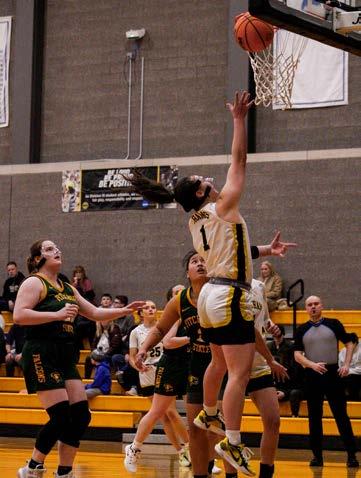
star of your team, to then coming to college, where you’re joining a team of all-stars. So remain confident in yourself, and if you put the work in, the results and the payback will be more rewarding,” she added.
to pursue after college, but it’s good I have that as an option.”
Okafor’s undergraduate degree will be in criminology, but he said that wasn’t his original plan. “I was originally a math major, but I had to switch it to my minor. … Math is my real passion.”
He said those he played basketball with from his hometown and the friends he made in college are people he will stick with after graduation.
“I’m still going to be playing basketball within my community in Hyde Park. It’s still a brotherhood where I’m from, and so everyone, no matter what age, they’re still playing basketball. We still have tournaments and leagues going on,” he said. His advice to freshmen is, “Do all the little things because it all matters.
“Make sure you’re taking care of your body, eating right, getting extra shots up every day, and don’t lose track of that, because you have enough time to do everything,” Okafor said.

By Taylor Kimmell Asst. Sports Editor
By Kyra Tolley Asst. Sports Editor
The Framingham State Rams split a doubleheader against the Hawks of the University of Hartford March 11.
FSU secured a victory during the first of the two non-conference games, winning their home opener 7-2 and falling 8-5 in the second game.
As the game began, plays from Captain and second baseman Brooke Grassia, a senior, and Captain and shortstop Makayla Rooney, a graduate student, prevented the Hawks from scoring during their first inning at bat.
At the plate, Rooney rocketed the ball out of the park for a solo home run, plating Framingham’s first run of the season.
Rooney said, “The first at bat being a home run after working hard all preseason was a great feeling. I think it had a good impact on my confidence at the plate. … I think that also helped in the team’s confidence altogether. Everyone contributed to that first big win.”
Next, freshman catcher Jocelyn Pepe made contact and singled for her first NCAA hit. Sophomore catcher Eliza Carignan hit a double, advancing Pepe to third and putting both runners in scoring position.
Later in the first inning, freshman outfielder Isabella MacDonald was thrown out on a fielder’s choice, her hit allowing Pepe to cross the plate. Additionally, Carignan scored on an RBI single from freshman Ava Sillings to conclude the scoring in the first inning.
Framingham’s bats continued to heat up during the second inning. Freshman outfielder Gianna Paolino singled on a hit to center field, her first NCAA hit. Grassia followed with a single of her own.
Rooney’s next at bat resulted in a run from Paolino and Grassia advanced to third. On the next play, Grassia scored on a wild pitch. The second inning ended 5-0 in favor of the Rams.
The third inning was uneventful, aside from the Rams’ defense showing
off on a double play, ending the inning for the Hawks.
A walk followed by a triple in the fourth inning led to Hartford’s first run of the game. They scored once more on a wild pitch before lining out to Rooney at shortstop, which closed the first half of the inning.
Freshman pitcher Sydney Bednarz took to the mound at the top of the fifth inning. The change in pitchers froze Hartford’s bats. Two batters popped up and one grounded out to Rooney, resulting in no hits in the inning.
Bednarz said she was eager to get on the field for her first appearance of the season.
She said, “Once I started throwing, I felt very comfortable on the mound. I was very grateful to have such a strong defense behind me and Jocelyn helping me out behind the plate for my first game.”
The Rams brought in two more runs during the fifth inning - Pepe and MacDonald both running in on a single from Sillings after being walked.
Bednarz kept Hartford to one hit in the sixth inning and a double from Grassia marked the only hit for the Rams.
At the top of the seventh inning, MacDonald caught a fly ball in right field, and Bednarz struck two batters out looking, wrapping up the game with a score of 7-2 for FSU.
The second game of the day got off to a slower start than the first, with no scoring plays for either team occurring in the first inning.
In the top of the second, freshman pitcher Audrey Gauthier walked the Hawks’ leadoff batter in the inning, who scored after a single from the next batter.
In a series of walked batters, a wild pitch, and a passed ball, Hartford scored two more runs.
In the bottom of the second, Framingham had ground to make up. Freshman Ava Gray came in for a pinch-hit and walked, but Sillings grounded out. Gray was still able to advance to second on the play.
The next batter for FSU walked as well, followed by senior Abby Behrikis, whose single allowed Gray to advance to third base. A wild pitch allowed Gray
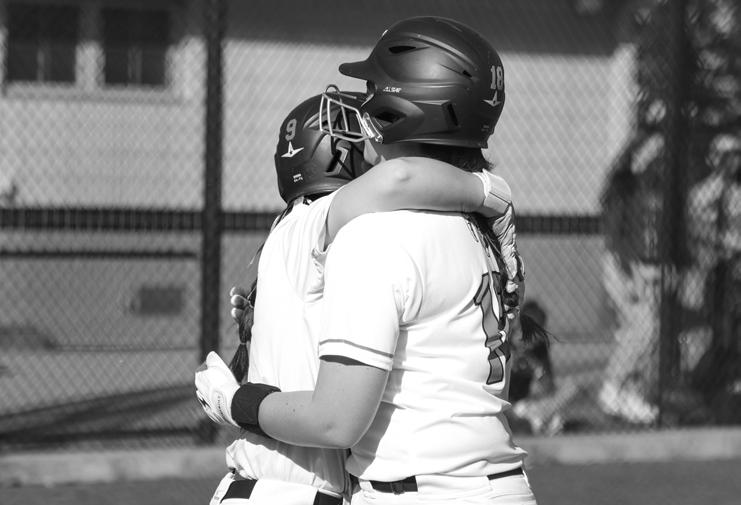
to run home and Behrikis moved over to third.
Behrikis scored off the next at bat to bring the score to 3-2 in favor of Hartford at the end of the second inning.
After a sequence of errors by Framingham in the top of the third, the Hawks executed a sacrifice bunt to safely put runners on second and third base.
Hartford’s next batter struck out looking, but two consecutive wild pitches by Gauthier resulted in two scored runs for the Hawks.
Luckily for the Rams, a fly ball from Hartford’s final batter of the inning gave them their third out.
To start the bottom of the third, Grassia singled, but Rooney hit a fly ball to left field for the Rams’ first out.
Two more singles from Pepe and Gray resulted in an RBI for Grassia and put two runners on base for the Rams. Sillings’ at bat got her to first base, but Pepe was thrown out at third.
With two runners on base, sophomore utility player Haley Jensen stepped up to pinch-hit.
Jensen hit a powerful double which sent two of her teammates home, tying the game 5-5.
Jensen said, “It felt great to have a successful first at bat of the season. Admittedly, I have struggled with the mental and confidence aspect of the game, so that was one of my main focuses of preseason, and seeing the
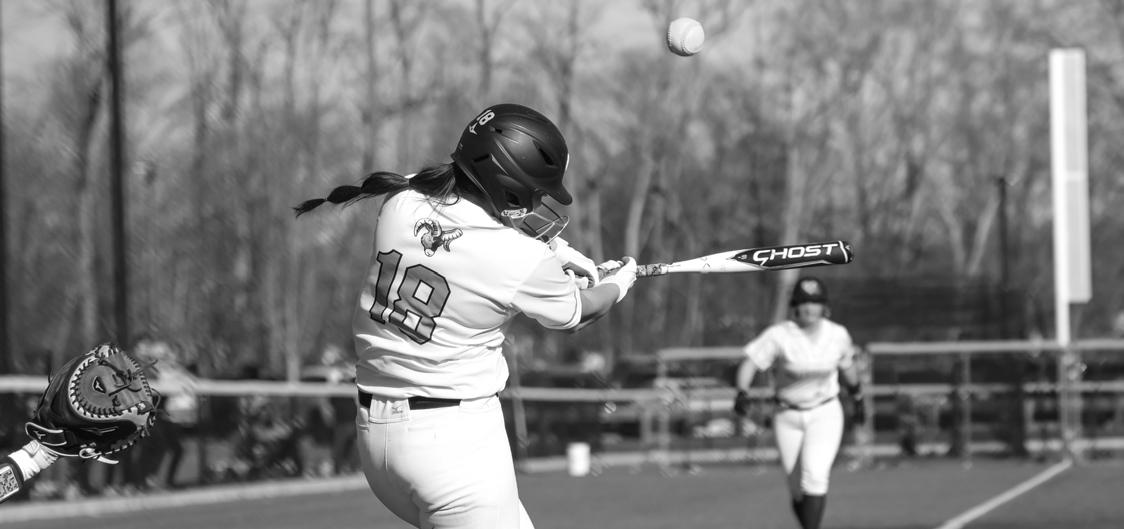
work pay off felt amazing.
“Coming up in a big spot and getting a timely hit to tie the game is definitely exciting and it’s so fulfilling to be able to capitalize on the success of my teammates,” she added.
Hartford ended the fourth inning with three players on base, but couldn’t score.
The Rams were up at bat in the bottom of the fourth inning, but three of their four batters failed to get on base, and the inning ended with a score of 5-5.
The fifth inning brought action for the Hawks and disappointment for the Rams.
Hartford capitalized off a fielding error to score their first run of the inning. Following two singles, the Hawks tripled to bring in both runners.
The final score was 8-5 in favor of the Hawks.
Head Coach Larry Miller said he’s very excited to see what the young talent can do this season, with 11 new players added to the roster.
“There is a lot of learning that needs to happen to play the game at this level well, but we do have two great leaders in our infield in Brooke Grassia and Makayla Rooney to help pave the way for these first-years,” he said.
Rooney said, “These younger players have so much skill and so much potential that they work so hard for every practice that they will be the future of Framingham State Softball.”
Next up, the team travels to Florida for their annual spring break trip.
Freshman pitcher Julie Chisholm said, “Florida will be a great opportunity to play some competitive teams, push ourselves, and have a lot of fun on and off the field.”
Upon their return, the Rams will face off against the Simmons College Sharks in a non-conference matchup March 26.
By Francisco Omar Fernandez Rodriguez Arts & Features Editor
The Center for Excellence in Learning, Teaching, Scholarship and Service (CELTSS) hosted a Scholarly & Creative Showcase Series, “Toward a Radical Pedagogy of Climate Change,” over Zoom March 7.
CELTSS Director Maria Alessandra Bollettino introduced the main speaker - Vandana Singh, a professor of physics and environment from the Department of Environment, Society, and Sustainability.
She also introduced the panelists - Benjamin Alberti, a professor of anthropology, sociology, and criminology; Kristen Abbott Bennett, a professor of English; Ishara Mills-Henry, a professor of chemistry and food science; and Folashadé Solomon, professor of education and assistant director of CELTSS.
Singh’s work has focused on “a transdisciplinary justice-centered reconceptualization of climate change at the intersection of science, ethics, society, and pedagogy,” Bollettino said.
Singh thanked Bollettino, the panelists, and the audience for the honor. She started with reading lines from her book, “Teaching Climate Change: Science, Stories, Justice.” It is a dramatized and slightly fictionalized version based on real life stories from Alaska, she said.
In the story, a scientist and his team set out on a nice day 30 years ago to study the sea ice, she said. But after they stepped from the shore ice to the sea ice, the Indigenous elder insisted that they had to get off the ice. Shortly after they did, that same ice broke off and floated into the ocean.
In that time period, being marooned on a lone ice floe in the middle of the Arctic Ocean was essentially a death sentence, she said. The scientists in the story were saved by the elder.
“He had thought that there was only one way to know the ice. But the ice hadn’t spoken to him - it had spoken to the elder,” Singh said.
She shared another story about a woman who was killed in a flash flood in Louisiana after heavy rains. The storm was more likely to happen because of climate change, she said.
The third story she shared was about a group of women in a small village in India who lived in an impoverished community. They “took their fate into their own hands and started to protect their forest and regenerate their forest,” Singh said.
She shares these stories with her freshman class on climate change,
she added. She started sharing them with her physics class in recent years.
When Singh learned how dire the situation with climate change is, she felt motivated to convey it to her students, she said. She hoped they might be future “change makers.”
As a theoretical physicist, she tried to do this with her general physics courses around 2010, she said. But she considers these attempts to be failures.
She shared some quotes from students from the time. Some felt “despair, anger, apathy, the kind that prevents people from feeling inspired for action,” she said.
But others still had misconceptions and misunderstandings about climate change, she added. “So I was failing on all accounts, and I always tell my students that failure is our best teacher, so I had to take those words to heart.”
There’s been research that shows this isn’t an isolated situation - the current method of teaching climate change isn’t enough to inspire people to action, Singh said.
A study in 2020 determined that one of the roadblocks is the lack of “radical visions for climate education,” she said.
After taking some time in Alaska to see the ice, she eventually came to the conclusion that because it doesn’t look like the climate crisis can be solved in our current frameworks, those conceptualizations must be let go, she said.
The crisis is inherently transdisciplinary, and can’t be effectively seen from only one perspective, she said. Only seeing it from the science or sociological angles isn’t sufficient.
It’s also deeply related to other problems, such as social inequality and the biosphere, she added. These connections result in unpleasant surprises.
Singh came across the concept of boundary objects recently, she said.
“Boundary objects are things that have specific meanings in specific contexts but they have a generally understood quasi-meaning,” she said. They can exist physically, but they can also be an abstract concept.
They help people be transdisciplinary, she said.
She started investigating boundary objects while trying to figure out what everyone needs to know about climate science in order to recognize misinformation and feel empowered to act, she said.
She came up with three transdisciplinary concepts that can serve as boundary objects, she said. They are balance and imbalance, critical thresholds, and complex intercon-
nections. These terms can be broadly understood by anyone but can also take on specific meanings in different disciplines.
Singh used the human body as an example of these concepts. If she stood on one foot, she could balance her body, she said. If someone pulled her arm, she might cross the line of being unable to recover her balancethe critical threshold.
In this scenario, imbalance would be falling down, she added. Lying on the floor would be a new state of balance.
The systems of the body, such as the eyes, ears, and nerves help the body determine if it is balanced or not, she said. They interact with each other to maintain balance and warn the body if they’re losing balance.
Different disciplines might recognize and specify these terms in different ways, but they are broadly recognizable, she added.
Next, she used the example of northern Alaska ice. The sea ice is gradually diminishing, she said.
“That’s because the processes that add sea ice to the Arctic have actually slowed down in comparison to processes that take away sea ice,” Singh said. This is a state of mass imbalance.
Less sea ice makes it harder to hunt, leaves more thin ice, and causes hungry polar bears to go into town more often, she said. The sea ice is also related to cultural identity.
She discussed the planetary boundaries concept, which is a fairly new and active field of research with some important critiques, she said.
“But what is not in question, really, is that we can’t do anything - we can’t do whatever the hell we want on this planet, that we are limited by natural cycles and tolerances,” Singh said.
Out of the nine planetary boundaries - the planet’s critical thresholds - that have been identified so far, as of last year six have been violated, she said. Their interconnectedness causes the violation of one to lead to the imbalance of others.
A complex system is made up of parts that can change their function because of how the relationship among parts can change, she said. She used the Arctic sea ice as an example.
“The melting of Arctic sea ice and the Greenland ice sheet actually affects ocean circulation in the Atlantic, which can, in turn, force moisture levels to drop over the Amazon rainforest and increase the chance of wildfires,” Singh said.
Mills-Henry said she had similar issues with trying to teach climate change in class as Singh did.
“So I appreciated that you also
had experienced that and realized that it was not enough to just teach the science about carbon dioxide,” Mills-Henry said.
Higher education was where she was challenged on her way of thinking, Mills-Henry said. “That’s why higher ed is important, because nowhere else will you be able to get those kinds of perspectives,” she said.
Bennett said in her field they’ve been thinking about marginalized voices and how knowledge has been passed down from “the age of exploration, which is recognizable as the age of exploitation.”
She feels empowered after reading Singh’s book to share some of Singh’s stories, Bennett said.
“You’re giving me language for describing what I’ve been trying to do, that I’m doing off instinct and passion and fear, and all those feelings we have when we’re thinking about the climate,” Bennett said.
The students will probably benefit from Singh’s framework of teaching climate change, Bennett added.
Alberti said he was struck by how Singh is arguing for epistemological expansion.
“What I took from your book is that this is not scientific epistemology 2.0 - this is not epistemology plus - it is an expansion,” Alberti said.
Singh reminds everyone of their responsibility to their constituents in a time when the federal government is gutting the Environmental Protection Agency, Alberti added.
Singh’s book shows everyone that by staying with each other, the students, and “all other companion species” the climate crisis can be confronted, Alberti said.
Solomon said the use of storytelling is a good way to help people engage with these ideas.
“I’m going to say that storytelling itself provides a way in - an accessto these very important components, but in ways that may be a little bit more accessible and less scary,” Solomon said.
She also liked the idea of making the climate crisis relevant to students.
“I think the final component that I wanted to talk about was this idea of again making things relevant to your students, or making them buy into this process of thinking about climate change,” Solomon said.
By Sophia Harris Editor-in-Chief
Early each Tuesday night, you might hear peals of laughter and conversations about getting that perfect stitch.
You definitely would not be able to hear a pin drop.
Alexis Claudio, a senior majoring in fashion merchandising, started a knitting and crocheting club, “Little Loopers.”
The small but mighty club gets together every Tuesday night to create goodies to donate to local hospitals.
These items include baby socks, hats, and blankets as well as scarves and gloves. At the end of the semester, the finished products will be donated to Shriners Children’s Hospital in Boston.
The members will work on these items throughout the semester, hoping to make a meaningful contribution by the end of the year.
“It’s all about learning, sharing, and giving back,” Claudio said. “We’re trying to make sure the community feels connected through this craft, and we also want to donate as much as we can to help those who need it.”
This is Little Loopers’ first year as a club, and because they do not have any funding yet, Claudio bought all the knitting and crocheting supplies for the club herself.
Claudio said the club “Is more than just a space to craft - it’s a community-building initiative with a big heart
for charity.”
The club was inspired by a similar organization at Claudio’s friend’s previous school, and since its inception, it has been dedicated to both building a supportive community and making a difference through handmade donations.
“The main reason that I started this club was just to build community amongst us as a group. I know that for me, learning how to knit and crochet was really hard on my own. So giving people the opportunity to be able to learn from other people physically, rather than just online, is a much better experience,” Claudio said.
Little Loopers isn’t just about knitting and crocheting in isolation. They plan to collaborate with other campus organizations to spread their love for crafting.
On March 4, the club teamed up with the fashion club to create crochet coasters, offering members a chance to learn and share skills through a new project.
Vice President of Fashion Club Eilish Heffernan said it was amazing to see some “familiar faces as well as students from all over campus” during the collaboration.
She added during the meeting, she learned how to crochet and she was happy that the partnership informed both parties about how to expand their crafts.
Publicist of Fashion Club Kenzy El Sayed said, “I think it was a great collaboration - especially since it was a
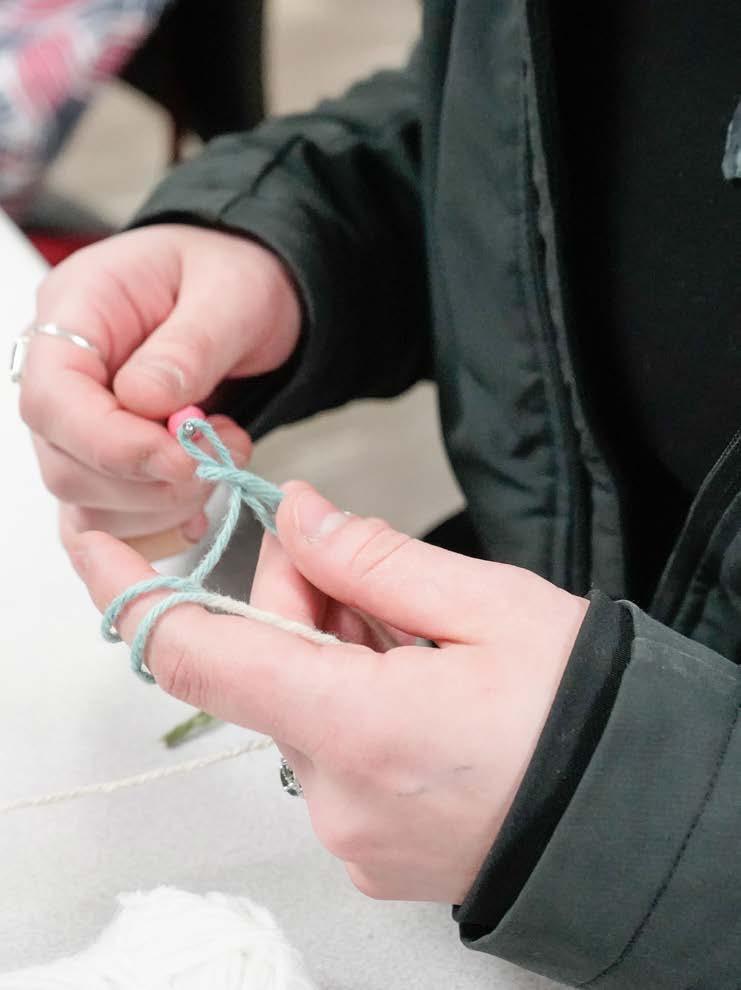

crochet workshop, which combined a common interest of both clubs.”
In addition, the club will be supporting the upcoming Fashion Show on May 4, at which they will be displaying their crocheted creations.
The club is also planning field trips as part of their programming. They intend to visit a senior citizen home to knit and crochet with the residents, fostering intergenerational bonds and spreading warmth through their creations.
Another exciting plan is a visit to a JOANN Fabrics store before the chain closes so members can obtain supplies to support their ongoing projects. Claudio said one of the driving forces behind the club is the desire to create a physical environment where students can come together to learn, share patterns, and support one another.
With a thriving online resource collection - thanks to sophomore Kendall Winston, who has provided various patterns and tutorial videos - the club also encourages members to meet in person to build stronger connections.
“The dorms are filled with students who enjoy knitting and crocheting,” Claudio explained. “The club allows them to take their passion to the next level and really bond over a shared interest.”
During the Tuesday night meetings, members share stories about what inspired them to start knitting and crocheting.
Winston, who transferred from the Maine College of Art and Design, learned the craft from a friend and saw it as an opportunity to connect with others. “Making things for people in need just feels really rewarding,” she said.
She added, “It’s an easy way to make other people happy because even something that takes an hour for me to make - it might mean the world
to someone else.”
Many club members shared they learned the skill from Winston herself.
Through these small acts of kindness, the club members have created a vibrant, supportive group where everyone is encouraged to learn and grow.
Little Loopers has a busy semester ahead with a packed calendar of events, field trips, and collaborations.
Members will continue to hone their skills and learn techniques like the mattress stitch and reading patterns.
With the continued growth of the club and its ongoing charitable efforts, it’s clear Little Loopers is weaving a strong and compassionate community - one stitch at a time.
Sophomore Joneisha Zuniga, vice president of Little Loopers, said the club means a lot to her because volunteering her time and skills to brighten the days of the children she will be donating to makes her reflect on her time as a pediatric patient.
“I was a pediatric patient, and I’m familiar with the hospital setting because of the many surgeries I’ve had,” Zuniga said. “I always looked forward to gifts that were donated. I want to offer back that same joy that I received.”
She added along with crocheting for this cause, she is also making “great connections with others. We learn a lot from each other and have a great time!”
Winston said, “Some people think this is an ‘older generation thing’ but I think it’s fun to keep it alive.”
Claudio said, “We’re here to learn, create, and give back. This club is about more than just crafting - it’s about making a difference together.”
CONNECT WITH SOPHIA HARRIS sharris9@student.framingham.edu
Continued from Page 1
A federal judge blocked the executive order for being unconstitutional and in violation of the 14th Amendment, added Bollettino.
The 14th Amendment was one of three additions to the Constitution after the Civil War, said Bollettino.
The Civil War, which was fought to liberate enslaved people, began the debate surrounding citizenship - “Who got to be an American?” she said.
While the 13th Amendment outlawed slavery, the 14th Amendment extended citizenship to formerly enslaved people, said Bollettino.
She said this was to ensure all Black Americans were fully protected by the law and were given the rights of citizenship, something they were not given before.
Enslaved people had no civil rights, said Adelman. They could not vote, testify in court, serve on juries, and usually could not own land.
Bollettino then read part of the 14th Amendment aloud. “No state shall make or enforce any law that shall abridge the privileges or immunities of citizens of the United States.
“This is the [clause] that is subject to debate, discussion, reinterpretation by the White House today,” she said.
Before the 14th Amendment, there was no clear way of determining who was a citizen because it was not stated in the Constitution, said Bollettino. Whether someone, including free Black Americans and white immigrants from countries such as Germany and Ireland, had the right to vote varied state-by-state and year-byyear.
“This was something that was actually subject to a whole lot of debate and discussion and political action in the early Republic, in the period leading up to the Civil War,” she added.
Enslaved people had no rights, said Adelman. Because of this, it was unclear what rights freed Black Americans held after the Civil War.
“The question in 1865 was, ‘There are 4 million formerly enslaved Black people - now what?’” Adelman added.
He said there was a significant number of free Black Americans in the 1820s through the 1850s pushing for the end of slavery and for their own rights.
The idea that it was impossible for America to be a racially integrated country came up in the 19th century, said Adelman. That led to a push to send people of African descent to live in Africa.
“Many of the Black people they were sending ‘back to Africa’ could trace their lineage in North America back more generations than the white people who were making the suggestion,” said Adelman.
Several thousand Black Americans were transported to West Africa, specifically Liberia and Sierra Leone, said Adelman.
“It was basically a movement to deport whole groups of people who
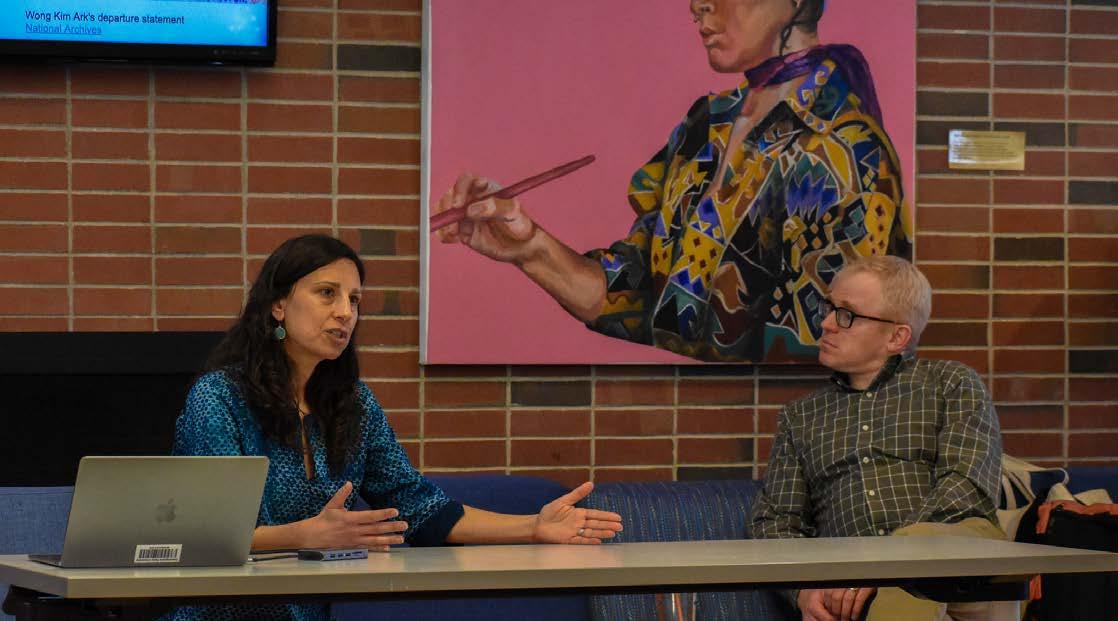
had been living as free people in the United States,” added Bollettino.
This led to debate, as Black people had mixed responses to this, she said. Some were convinced they could not live safely in the U.S. and that their rights would not be honored.
“But others said, ‘Hell no, we are Americans. … What we actually deserve is full and complete rights of citizenship in the nation of our birth.’”
The 14th Amendment was the culmination of those Black Americans who argued for birthright citizenship throughout and after the Civil War, said Bollettino.
An attendee commented on how birthright citizenship was originally created to give rights to Black Americans and is now usually discussed in relation to immigrants coming to the U.S.
“It has ended up serving as a touchstone for all manners of groups of people who have been arguing that they are citizens of the United States,” said Bollettino.
Bollettino then discussed a pivotal moment in the debate of birthright citizenship, the Supreme Court case, United States v. Wong Kim Ark.
Ark, the child of two Chinese immigrants, was born in San Francisco, said Bollettino, where he spent the first eight years of his life.
“This was a moment where many Chinese laborers had come into the United States to work on the Transcontinental Railroad, to serve as agricultural laborers, to mine for gold and other precious metals in the west,” Bollettino added.
When an economic downturn hit the U.S., many Americans began to see Chinese laborers as competition in the job market. This resulted in a political movement called the Chinese Exclusion Act of 1882, which aimed to stop Chinese laborers from coming to the country, she said.
“The United States basically wanted to enforce and extend the Chinese Exclusion Act, so they were looking for a test case of this clause in the 14th Amendment that guaranteed
birthright citizenship,” said Bollettino.
Ark’s parents moved back to China and he moved back and forth between China and the U.S., she said. He went back to China to find a wife, but when he returned to the U.S., he was denied entry.
“The attempt was to basically tell Wong Kim Ark, ‘Actually, no, you’re not a citizen even though you were born in this country.’” she added.
He protested his detention and won with the help of many Chinese organizations who protested with him. The U.S. appealed the case until it was brought to the Supreme Court, said Bollettino.
The Supreme Court ruled six to two in favor of Ark.
This same Supreme Court later ruled in the Plessy v. Ferguson trial, which cemented “separate but equal” laws. “So not the most racially enlightened of courts to say the least, but nonetheless argued, yes, the 14th Amendment guarantees birthright citizenship,” she added.
Bollettino then read some exceptions to birthright citizenship, such as children of foreign leaders and children of enemies born during a hostile invasion. Indigenous people with direct allegiances to their tribes was another exception.
“Everybody not listed in those exceptions - of whatever race or color - domiciled within the United States, and every citizen or subject of another country while domiciled here is within the allegiance and the protection [of the U.S.] and is consequently subject to the jurisdiction of of the United States,” Bollettino read from the 14th Amendment.
“How it is interpreted now is a question that’s readily up for debate,” added Adelman.
Adelman said the Trump administration is aiming to reinterpret this jurisdiction clause of the 14th Amendment in order to limit the number of people who count as citizens.
The administration argues that if someone’s parents are not legal citi-
zens of the U.S., they are not subject to the jurisdiction of the U.S. because they are still under the jurisdiction of the country they are from, said Adelman.
“Another way to think about it is loyalty,” added Bollettino. The administration claims an immigrant’s loyalty is not to the U.S., it’s to their home country.
She said the intent of the executive order may be to discourage people from having children in the U.S. if they know their children will not have birthright citizenship.
“It’s different from how it’s been interpreted and was interpreted in the past,” she said.
The Constitution was made to set up the framework for Congress and the president to decide which laws to pass, said Adelman.
He said an executive order is an interpretation of the law that Congress can either pass or challenge.
Adelman and Bollettino closed the discussion by thanking everyone for attending and Jerome Burke, director of the CIE, thanked them for coming.
“I can speak for everyone that we learned something,” said Burke.
“One of the hallmarks of teaching U.S. history is understanding the extent to which civic participation is important,” added Adelman.
Bollettino said everyone being informed on what is going on in the country is a key part of making democracy work.
“Democracy relies on active participation and engagement,” Adelman said.
He said it was possible for people to be more educated on what is going on in their community by going to classes or city council meetings.
“It’s annoying that it’s hard work, but democracy is hard work - stay engaged and come to things and ask questions,” Adelman added.

By Owen Glancy Arts & Features Editor
Quentin Tarantino’s “Kill Bill” films are two of his best and most popular, standing out even amongst his already iconic filmography with its bright colors, snappy cinematography, and bits of animation sprinkled in throughout the first film.
All of that being said however, neither “Kill Bill” film would exist without Toshiya Fujita’s “Lady Snowblood.” In interviews Tarantino said he was inspired by “Lady Snowblood,” and it certainly shows.
You would be foolish to believe that the only reason to watch “Lady Snowblood” is to see where Tarantino gets his inspiration from though, as the film is one of the best revenge and samurai stories out there.
The film follows Yuki, our titular “Lady Snowblood,” as she tracks down three of the four people responsible for assaulting her mother over two decades ago. If it wasn’t immediately obvious by that very brief synopsis, this is a unique film about revenge as in actuality, the one doing the revenge is incredibly discon-

By Bella Omar Asst. Arts & Features Editor
Curator of Electrix Vintage (@ electrixvintage on Instagram), Danny Colon has graciously extended his eye for vintage style into design with the launch of “The 90s” sweatpants.
The Fashion Institute of Technology (FIT) fashion business management major said he began curating and selling vintage clothing during quarantine and “only had money from my part-time job at my local bagel shop. … So Electrix started with zero dollars. It began with me selling items out of my closet on Depop and from that we were able to save up the money for the studio and retail space eventually.
“Electrix has been built on storytelling through vintage clothing,” he said, with the brand consistently
nected from the actual crime itself. Yuki was not alive for this incident, and has no relation to any of the men or women who committed the crime over 20 years ago, yet she is spurned by her mother’s dying words of malice to “become an asura,” a demon in Japanese folklore fixated on revenge.
By disconnecting the protagonist from the antagonists, the viewer begins to question the validity and necessity of this quest for vengeance from the very beginning. Obviously these horrible people need to be brought to justice, but in her pursuit of this justice, Yuki loses everything that makes her human, fully devoting herself to the path of an asura.
While the theme of “revenge is bad” is not new, and was not new in 1973 when the film released, it’s the way this story is told that makes the film so fresh even today. The visual language of “Lady Snowblood” is unique, often taking a step back from the protagonist. Every shot looks like a painting.
The colors in this film are absolutely stunning, with the bright reds and yellows sharply contrasting against the pitch black nights and pure white snowfall that many of the film’s action scenes take place during. However, Yuki’s birth is easily the best looking scene in the entire film.
The colors of the snow are bright red rather than the familiar white, almost as if it is snowing blood as the storm surrounds her cell as Yuki’s mother, played by Miyoko Akaza,
dropping creative collections and coinciding campaigns, all of which feel like stills from a Sundance nominee.
After years of exciting vintage curation out of Williamsburg, Colon’s recent itch for design actually sprouted from a trip to Chicago.
“I had forgotten to pack a pair of sweatpants. I walked around Chicago with my brother to find some and could just not find any that I loved,” he said.
Colon had a specific vision for what he and frankly every other ’90s fashion devotee was searching for in a sweatpant and in July of last summer, he and his team began the process of bringing that perfect vision to life.
“It really was a true startto-finish process, like the fabric alone took us three months to decide on,” he said.
“And I’ve always wanted to make things - I’ve always admired the design students.”
delivers a spine chilling monologue about her desire for vengeance - she cares about her daughter not because she is her daughter, but because she can fulfill a revenge she herself cannot.
Even though none of the film’s
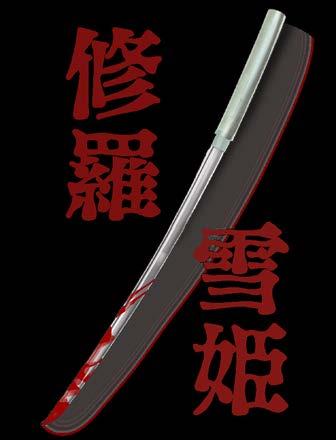
other scenes can quite reach the heights of Yuki’s birth, the many action scenes come very close. Yuki’s thin sword, which she unsheathes from the base of her umbrella, is not only really cool, but also a great representation of how all of her opponents see her. Many of the film’s fights start with an overconfident opponent seeing Yuki as nothing but a defenseless woman, only to be cut down near effortlessly by her.
These scenes never get stale how-
quantity of fewer than 100 pairs of “The 90s” sweatpants.
“They’ve been really awesome,” he
ever, as every fight feels different and distinct from the last. From the opening fight in the snow, to the cramped and chaotic battle in a storage room, to the climatic final fight taking place across a massive party, every single conflict is gripping and bloody - the film really earns the name “Lady Snowblood.”
Sadly, it feels as if “Lady Snowblood” is only becoming more and more obscure as time goes on. Its name and the decade of its release make many think that this is one of the multitude of cheap exploitation films of the time that put more focus on sex and gore than on art and storytelling, something that could not be less true about “Lady Snowblood.” It also doesn’t help that it wasn’t made by a big name director or studio like Akira Kurosawa or Toei, but that does not mean it deserves to be overshadowed and forgotten.
Though it lives on nowadays through another film made nearly three decades after its release, “Lady Snowblood” still lives on. If any film deserves to be seen by more people and to be considered one of the best movies in its genre, it is undoubtedly “Lady Snowblood.”
You can stream “Lady Snowblood” on Max.
CONNECT WITH OWEN GLANCY oglancy@student.framingham.edu
way over any body type. The fabric of choice also being one-of-one makes the pairs that much more special.
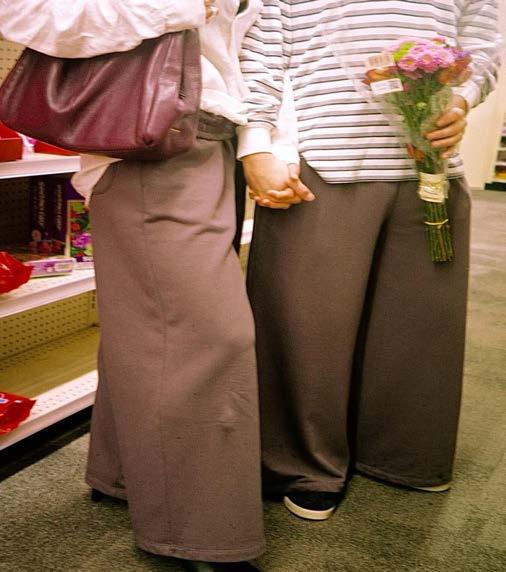
In the beginning of the design process, Colon said he “was literally taking pictures of people’s sweatpants on the street for inspiration.”
With sustainability in mind as always, the Electrix team worked with an ethical factory based out of New York City’s Garment District to design and produce the very thoughtful
said, as the factory was able to assist with every step of the process.
The final product is a wide-legged picture of thoughtfulness, with every detail being a clearly considered homage to Colon’s affinity for vintage quality.
Fabricated with 100% deadstock cotton 420 GSM terry cloth, the charcoal pants would drape in a flattering
In addition to two almost-invisible side seam pockets, the pants feature a third backside patch pocket designed to comfortably hold your iPhone without sagging - an elevated detail that adds merit to the piece’s $125 price point.
With comfort in mind, Colon and his team chose an extra-wide and flexible waistband sans drawstringadding range to the small to extra large size options without sacrificing seamlessness.
This gift to fashion-minded individuals dropped on Feb. 21 at 5 p.m. on Electrix’s Instagram. Campaign materials lit with nostalgia featured couples donning the pants around NYC, with the intimately posed shots feeling like love letters to couples everywhere.
Electrix’s debut in clothing design was an artful success, leaving all of us with plenty of anticipation for whatever Colon and his team create next - and between you and me, look out for something brief around April.
By Alexis Schlesinger Editorial Staff
It has been over five and a half years between Chase Petra’s release of their first album - “Liminal,” and their second - “Lullabies For Dogs.”
The long wait was more than worth it.
“Lullabies For Dogs” explores topics of growing and changing, themes the band stated are essential to their purpose.
“Centrifugal Force” opens the album. The song explores finding yourself after learning what you were taught growing up was false. Hunter Allen, the lead singer, tells us to consider she was “raised on a fairytale” that was repeated over and over - how could it be wrong?
“Catharsis” explores becoming passionate to a fault, realizing you’ve idolized your pain as inspiration. Hunter can’t separate it from what they create. Now people can’t see her sadness as sadness, only the beautiful product.
Chase Petra finally released a love song - “Two Nights in New York” gently tells us the story of Hunter falling in love. She sings, “I didn’t know we were falling in love / thought we were just dancing.” She describes the relief in finally feeling soft and loved.
“Have Faith, Horatio” criticizes people who can’t unlearn toxic religious values. Hunter hasn’t gained anything from religion, but that
doesn’t mean it’s worthless. You can find your place in heaven without “saving her,” though.
One specific lyric, combined with musical technique, stands out in “Bread and Circus.” Hunter includes a run - consecutive notes (three or more) sung in rapid succession as a scale - while singing the lyric “run.” The song thematically covers feeling that your life is a performance you can’t get away from.
“Icarus” is the shortest track. It’s the transition into the second half of the album. It builds tension hard in just 43 seconds, as we listen to Hunter’s existentialism on how things “can’t” be this hard.
“She Simply Left” longs for certainty. The only answer some people can give to uncertainty is “maybe God is dead.” Allen tells us she thinks maybe “She” simply left.
“The Needle” and “The Suture” combine to take us through struggling to let your childhood self go because it wasn’t nurtured properly.

Ben Hurney / THE GATEPOST
“Because I Am My Own Dog” is a heavy hitter with its metaphor of being a “bulldozer.” Hunter tells us to “look out” for the bulldozer, that “you don’t want to know her.” The implication being, she is the bulldozer. She is seen as combative, and that she attacks everyone who comes toward her.
In “The Needle,”she explains the last time she may have been “whole” was summer of 2008 in her bedroom.
“The Suture” follows up with the rebellion she explores trying to find herself, but it doesn’t heal her.
“A Bug’s Life” follows, telling us that despite how harsh some reactions have been to certain people, Hunter doesn’t regret anything. Why don’t you go through it, then tell us how you’d react?
“IWYTWT” yearns. The acronym expands to “I want you to want to.” Hunter wants her lover to want her despite her “brutality” at times. They
can have her anyway they want, as long as they love all of her.
The closer to this album is “Hospital Bills and Scratchers.” Hunter asks if we can hear her, and if we can see her. She knows she is one in a million, but could we still move with her? She might be running out of time, but she won’t slow down until you hear her. The final line in the song, and the entire album, concludes “Lullabies for Dogs” perfectly.
“Can you hear me? I’m not done singing or screaming, I’m not-”
The abrupt stop, seemingly mid-sentence, emphasizes her message that she is not done fighting to be heard.
Chase Petra uses this album to explore the deepest, most vulnerable parts of us, and brings them to light with technical expertise and lyrical genius.

Rating:
